Developing Technologies: Robotics & Drones (Presentation)

|
Author: Chris Miceli |

|
Dated: 2018-12-13 |

|
Uploaded: 2018-12-13 |

|
Last Edited: 6 years ago |
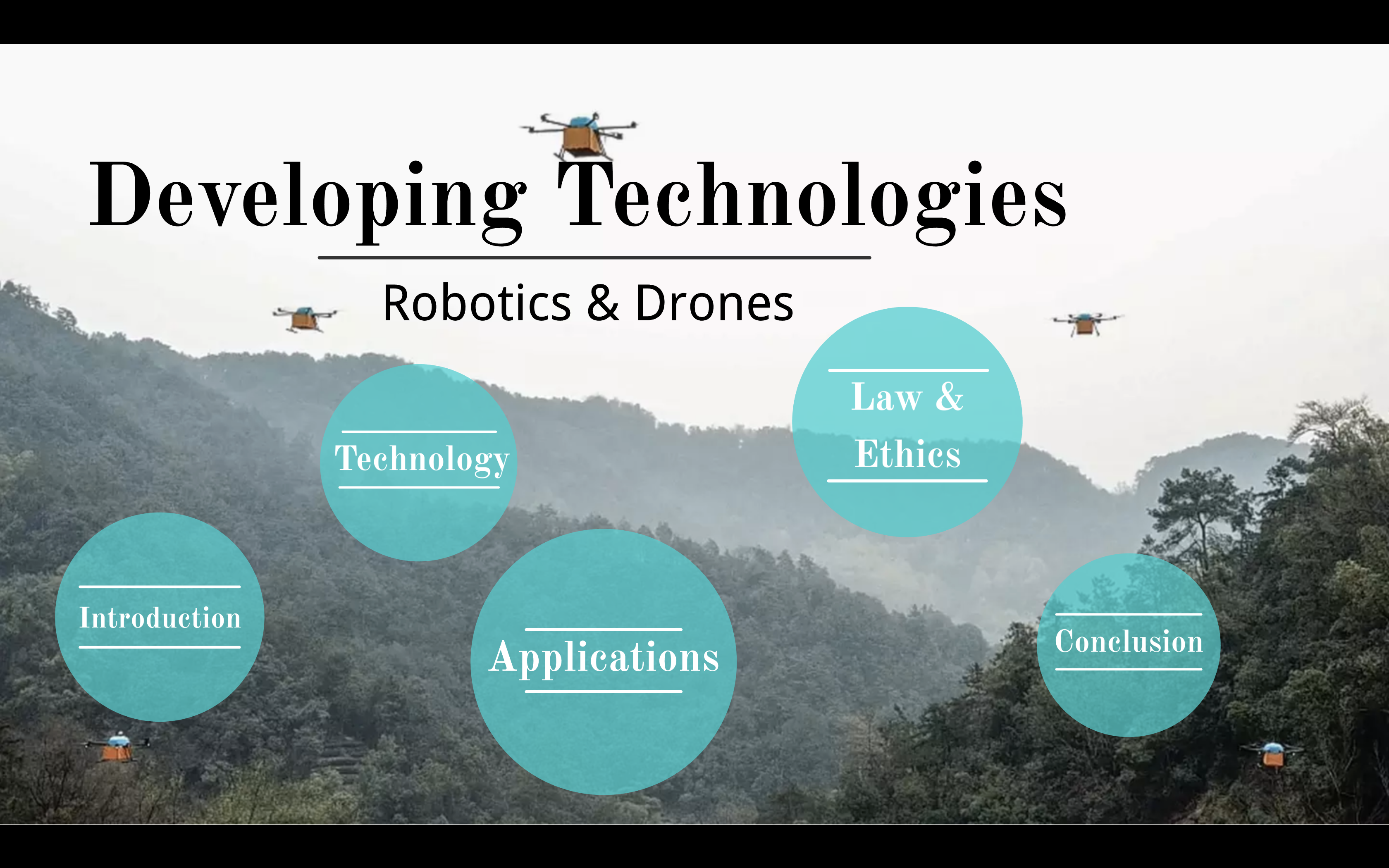
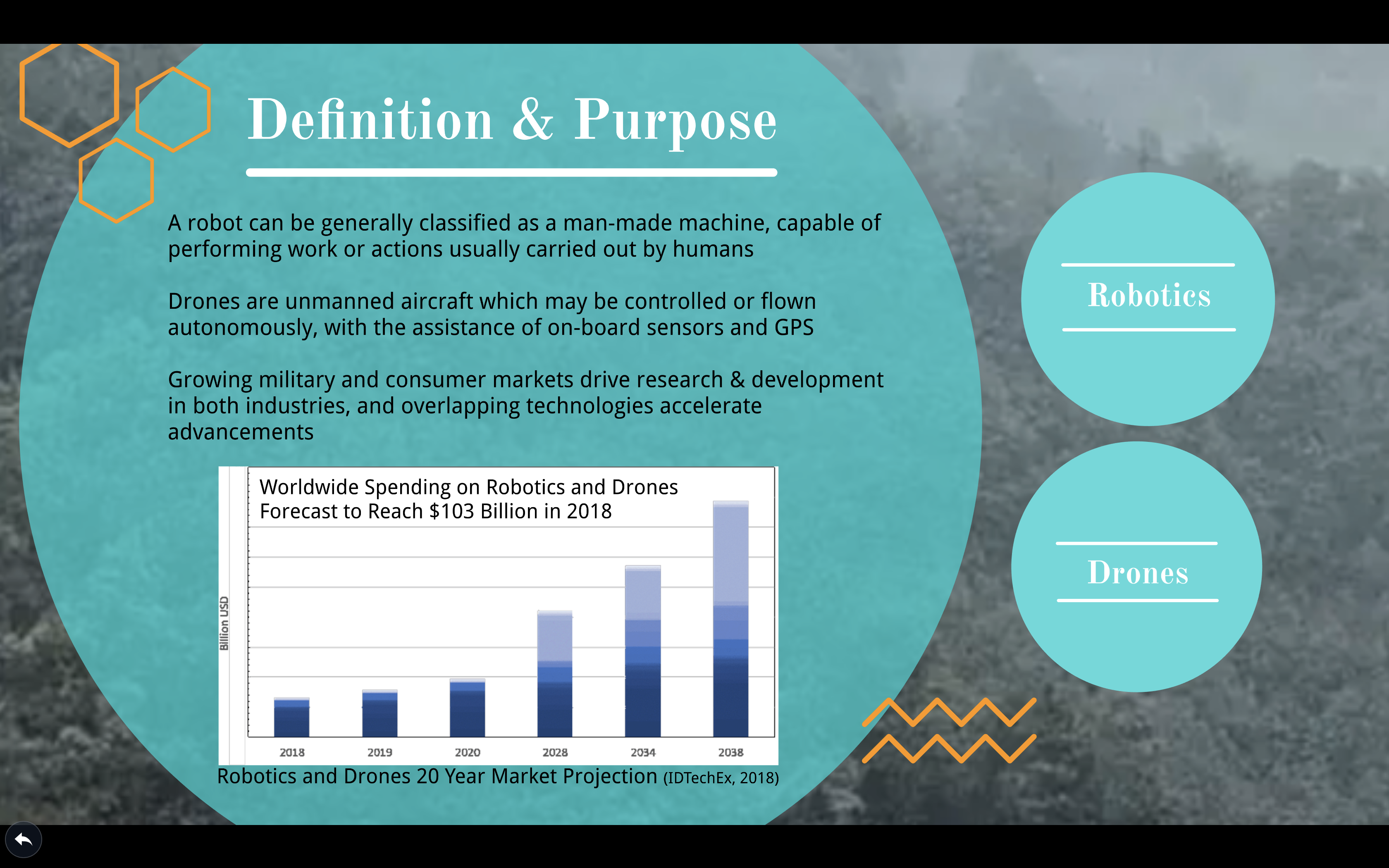
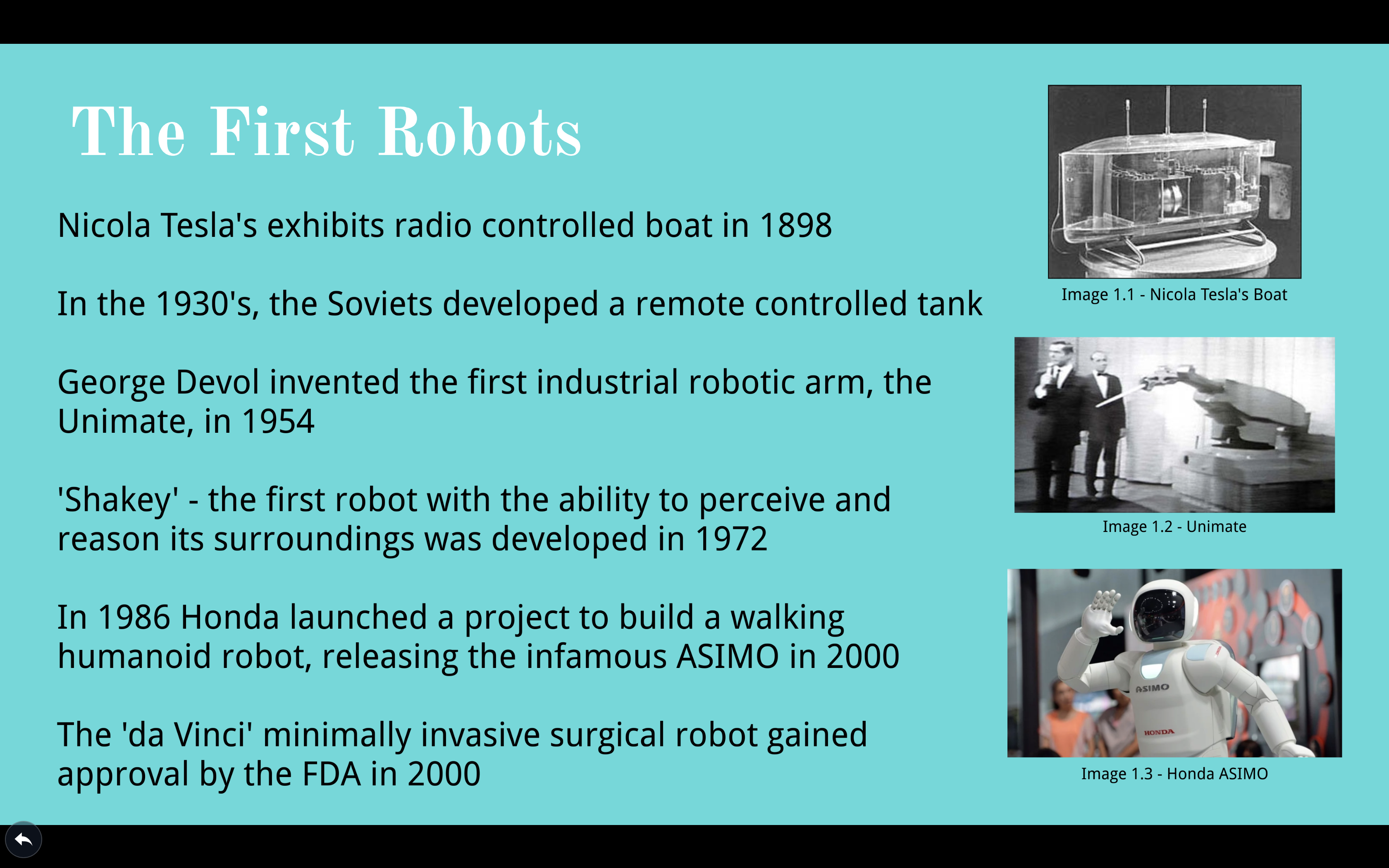
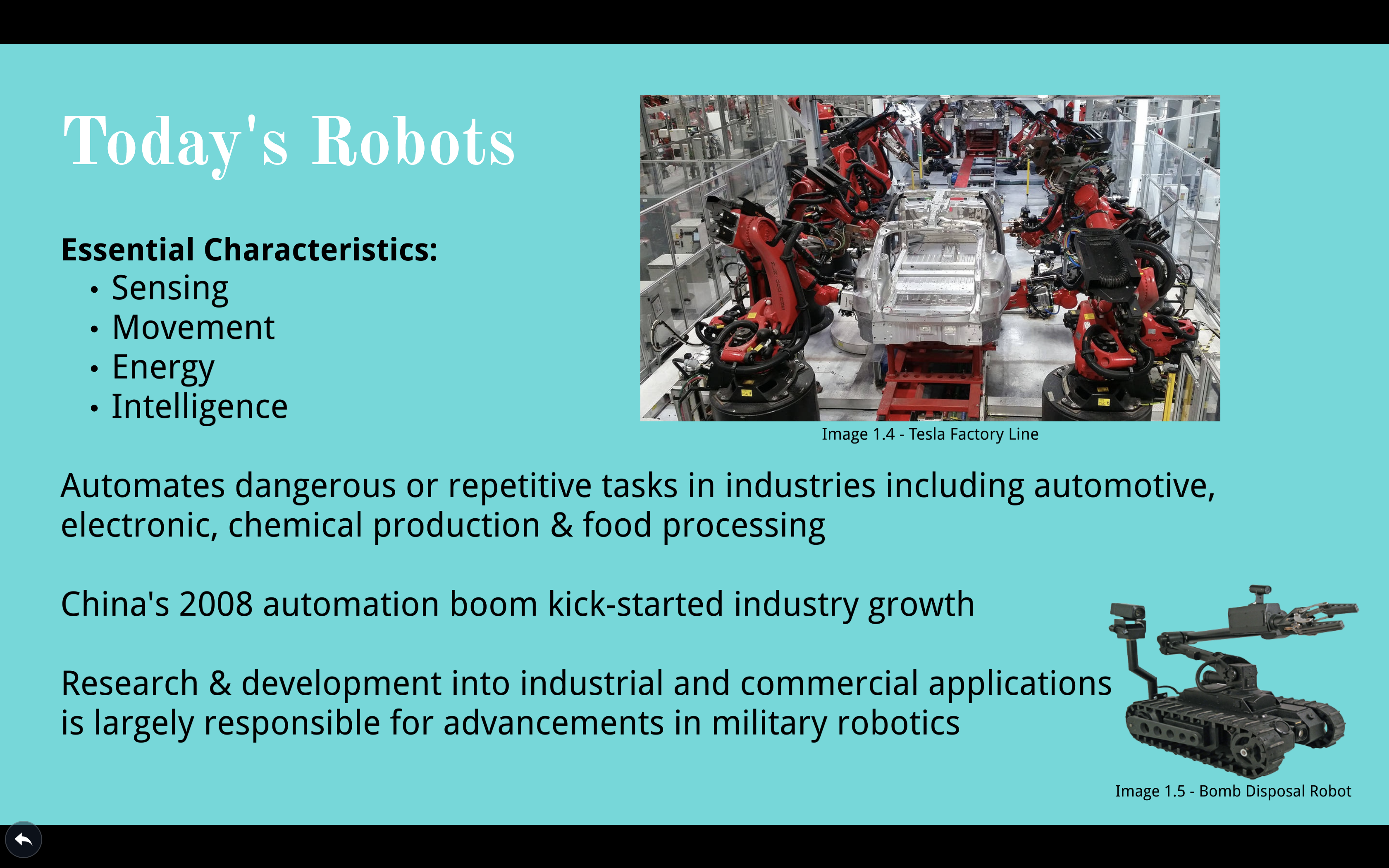
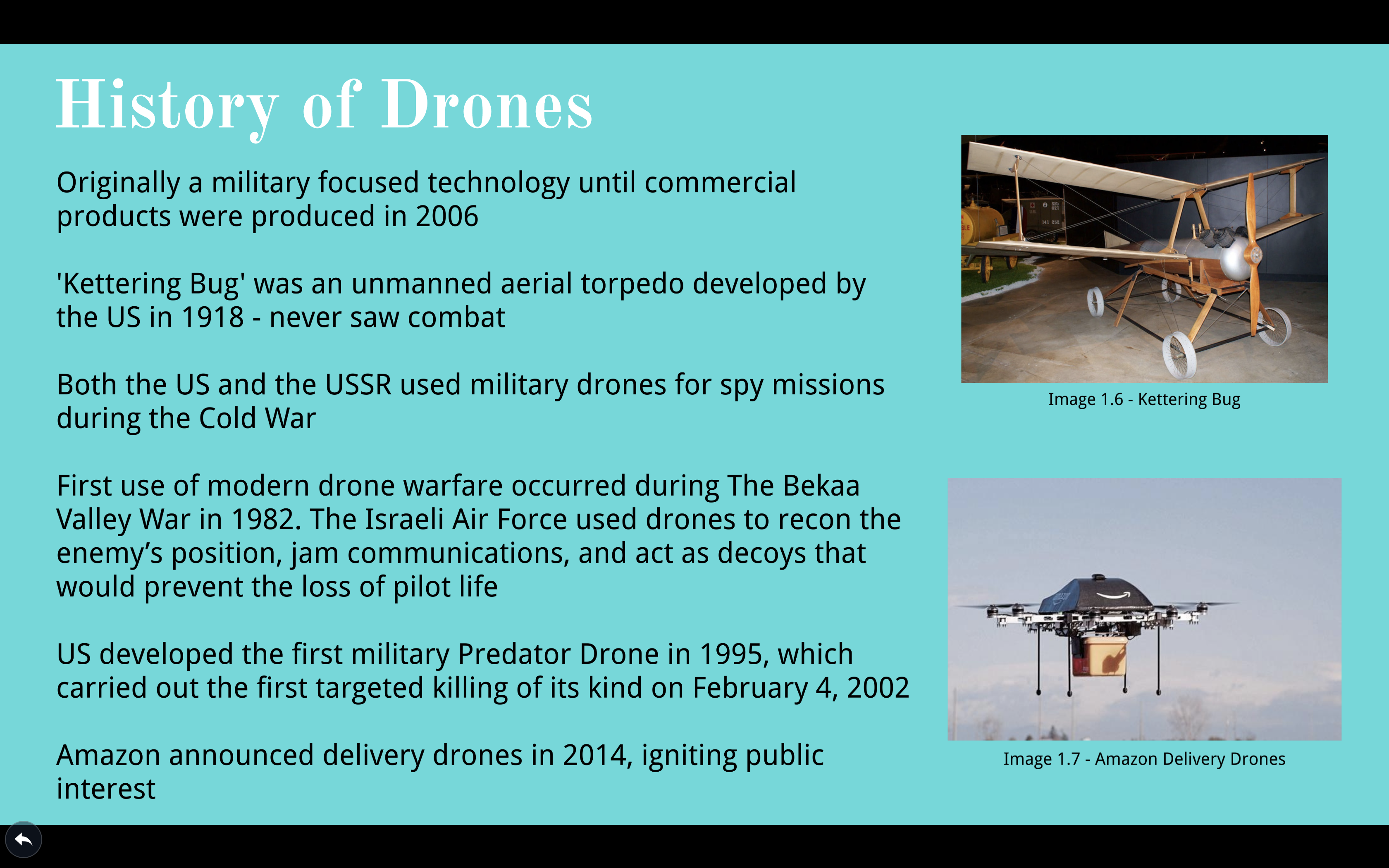
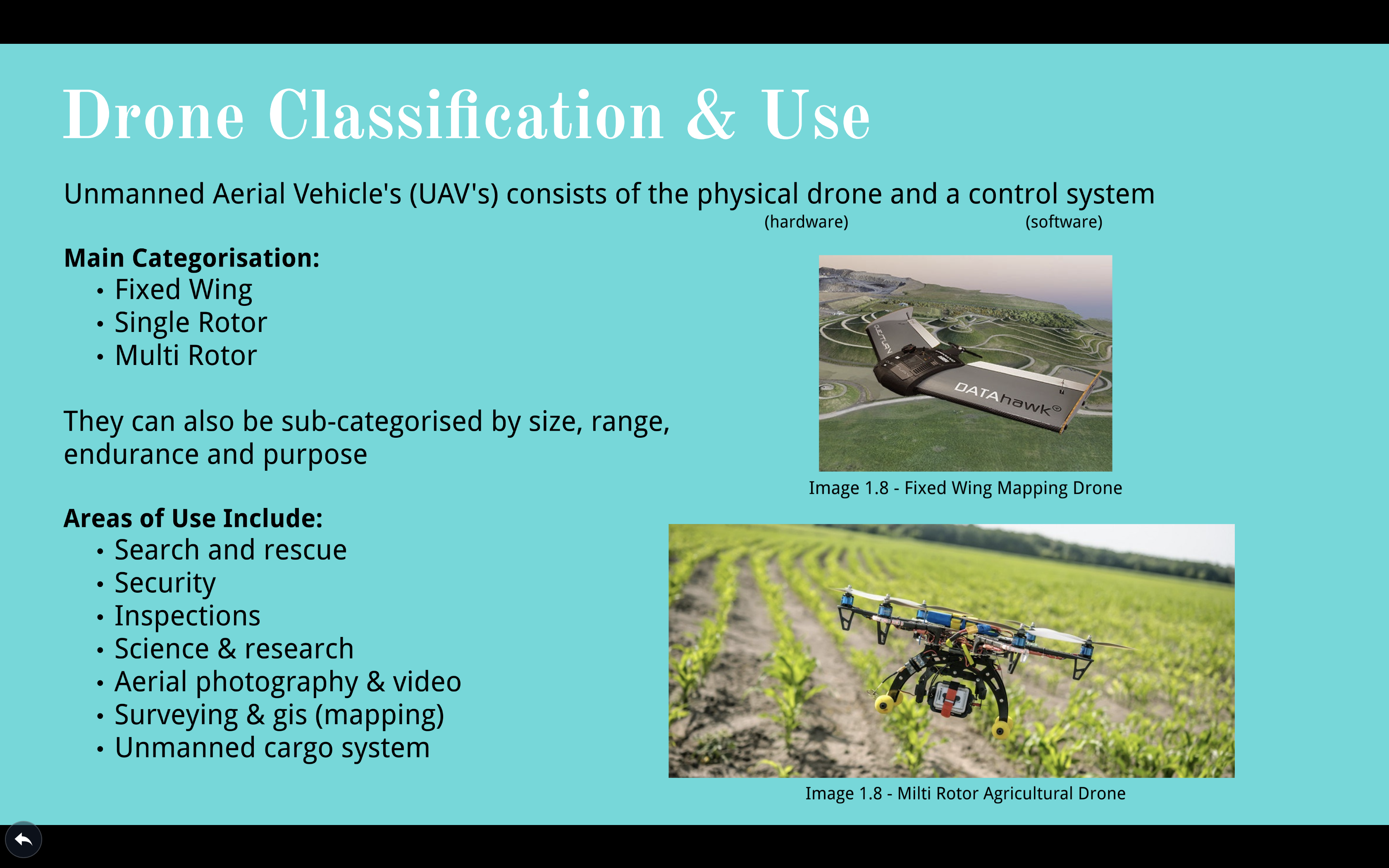
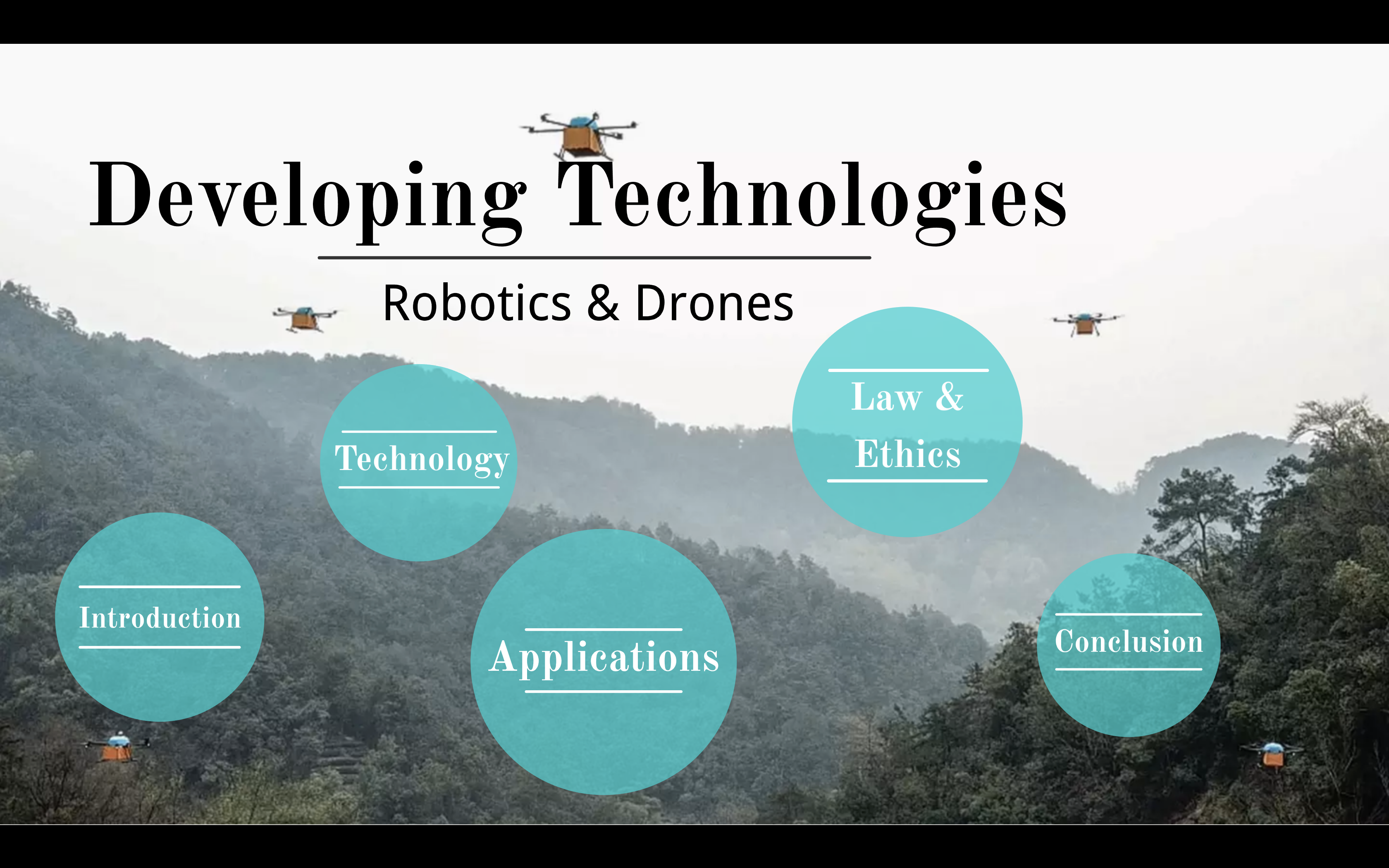
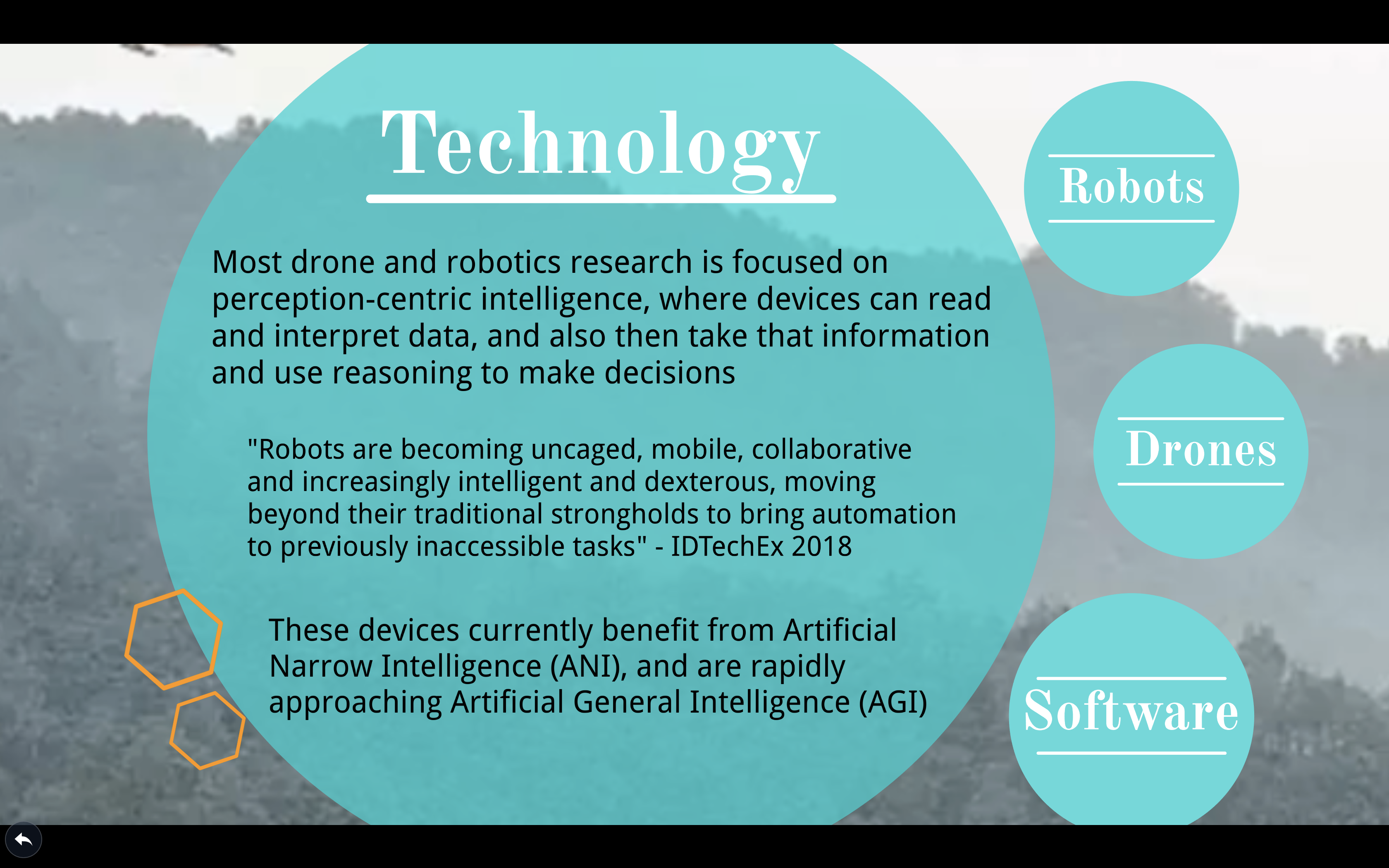
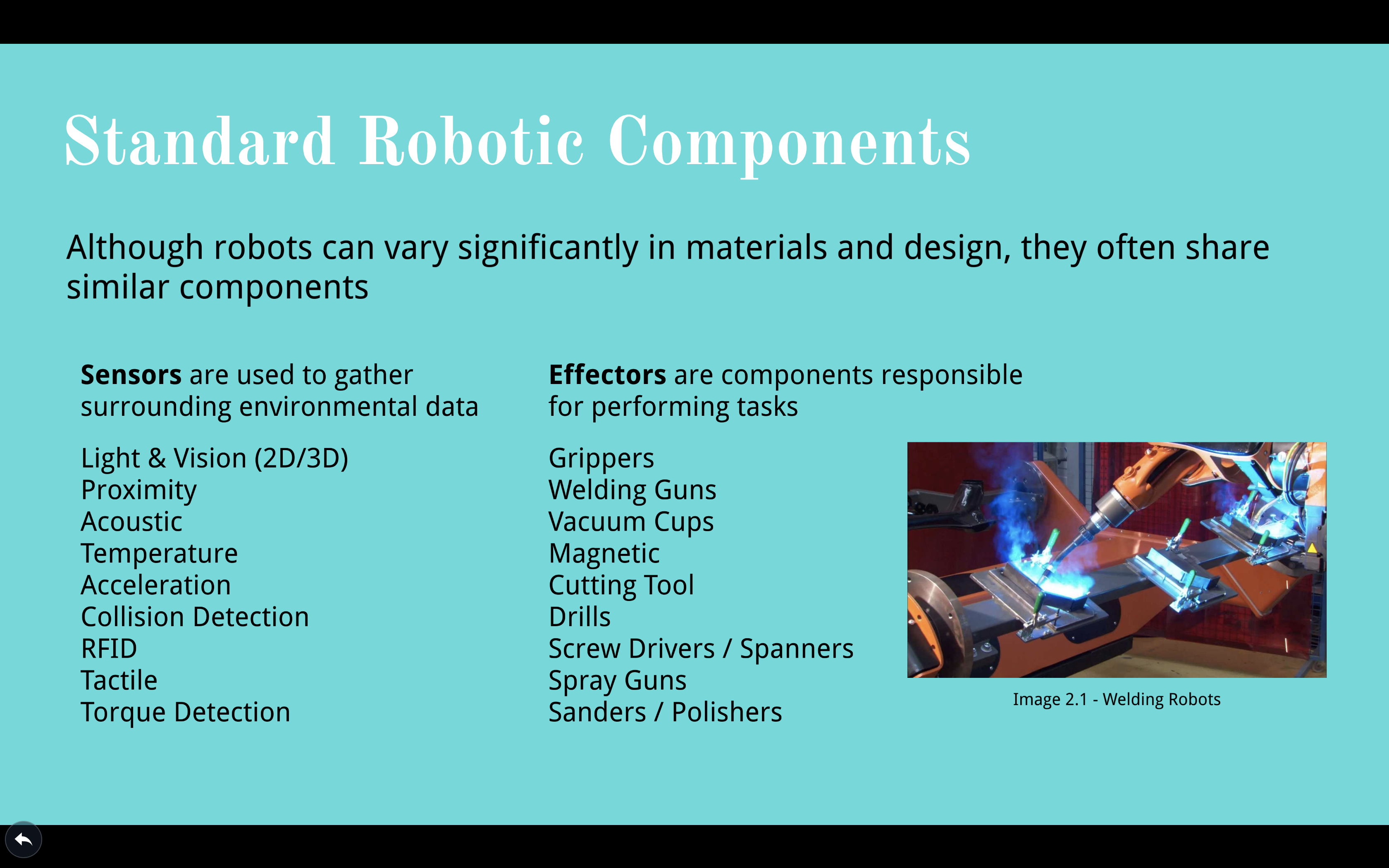
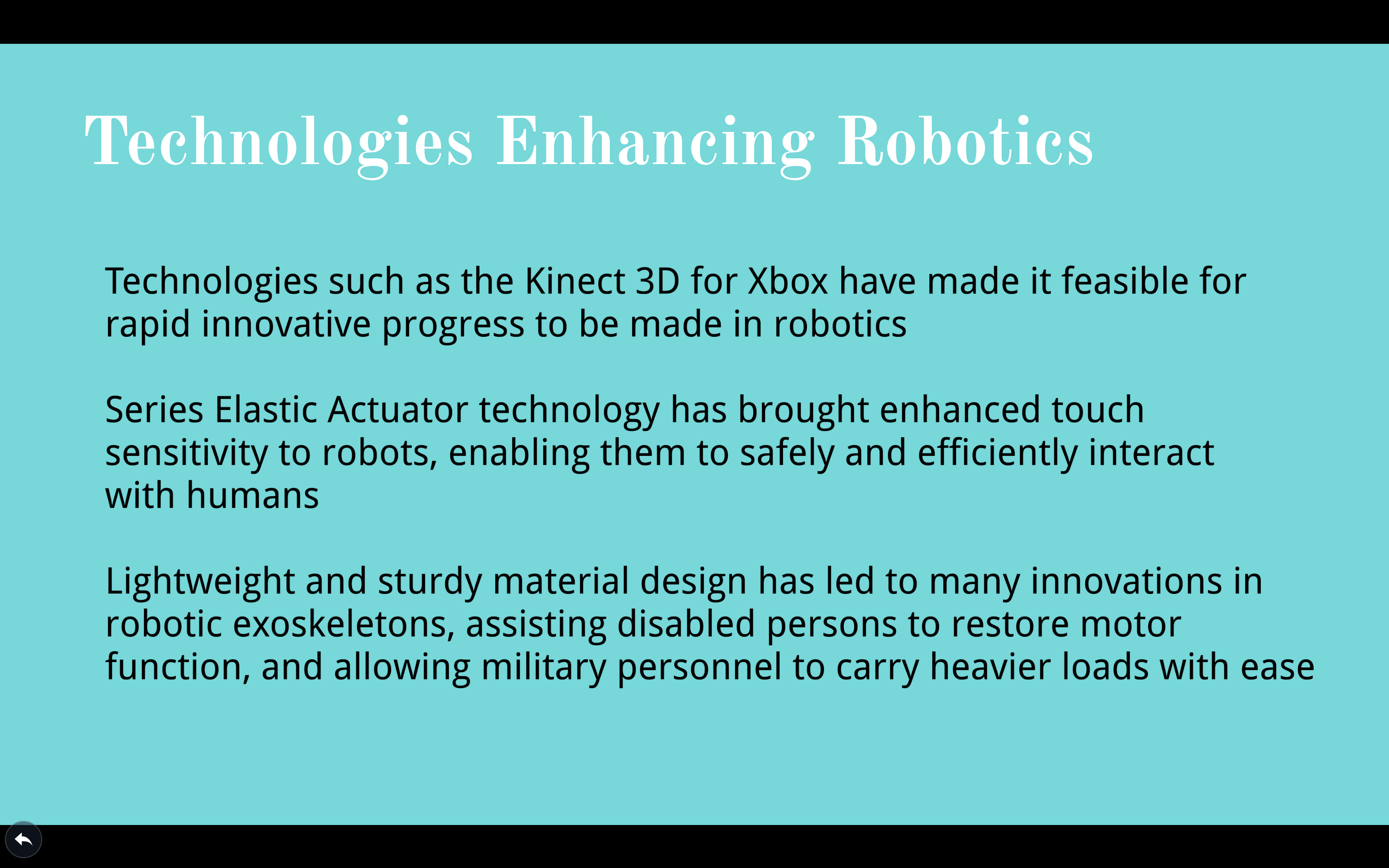
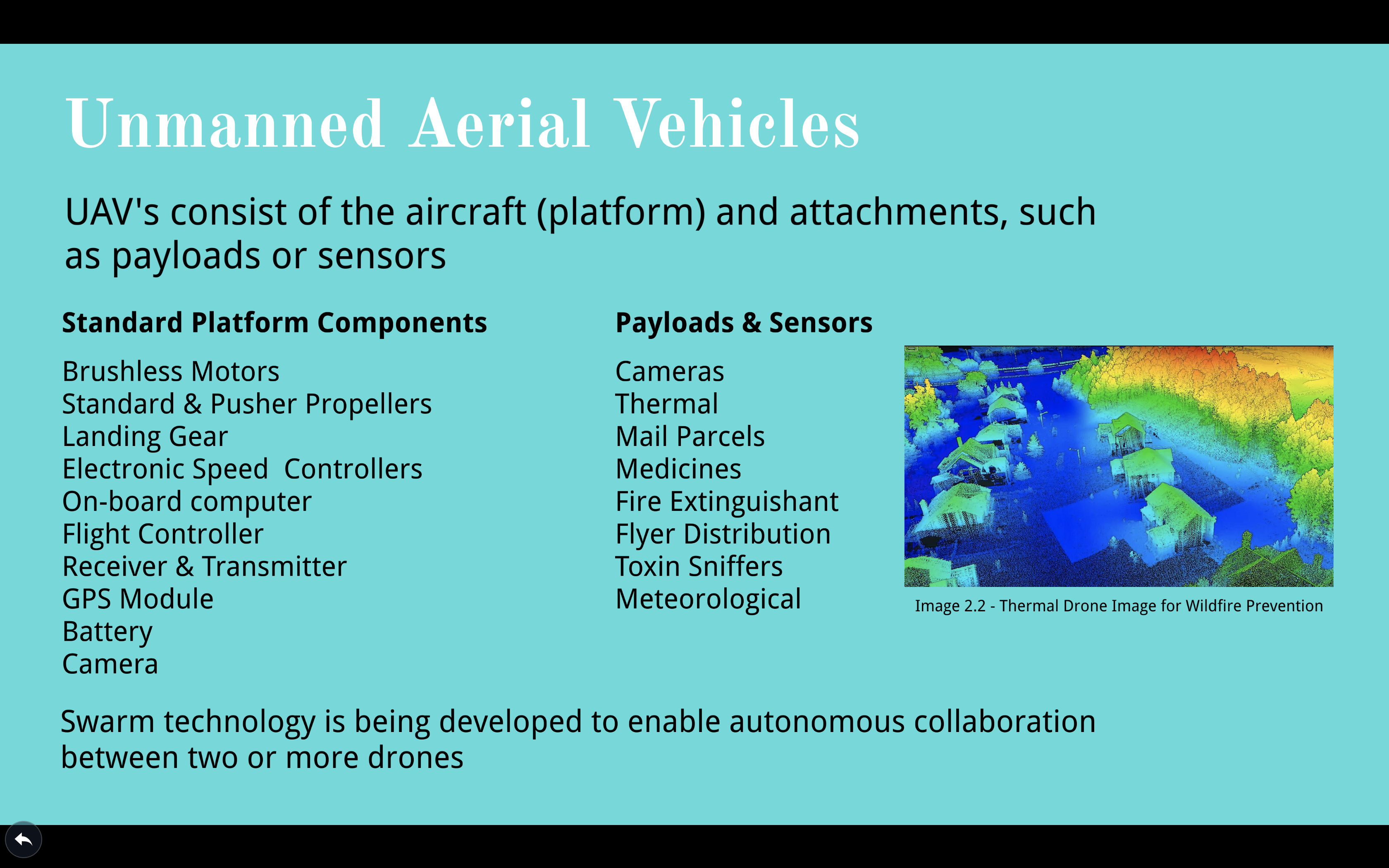
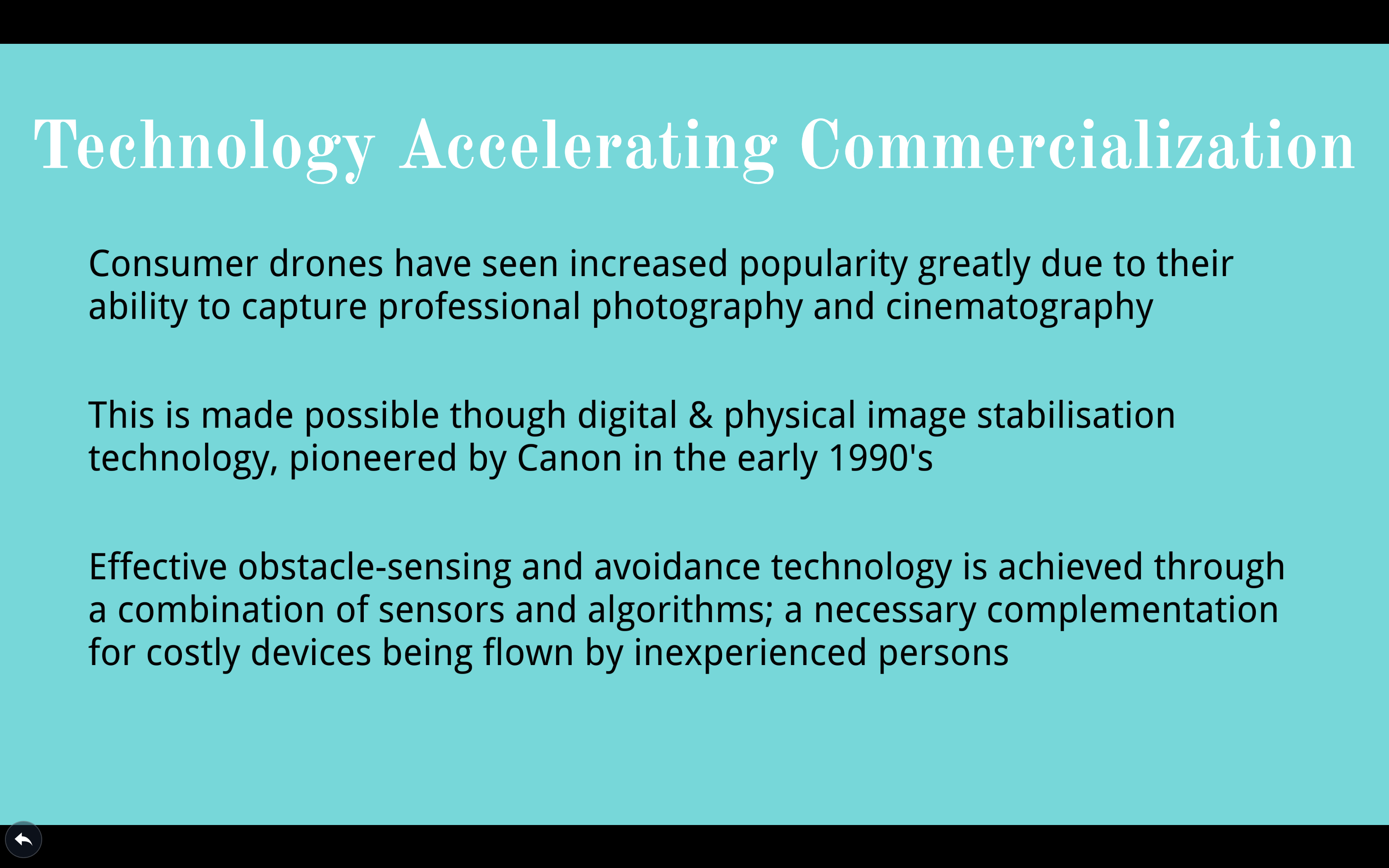
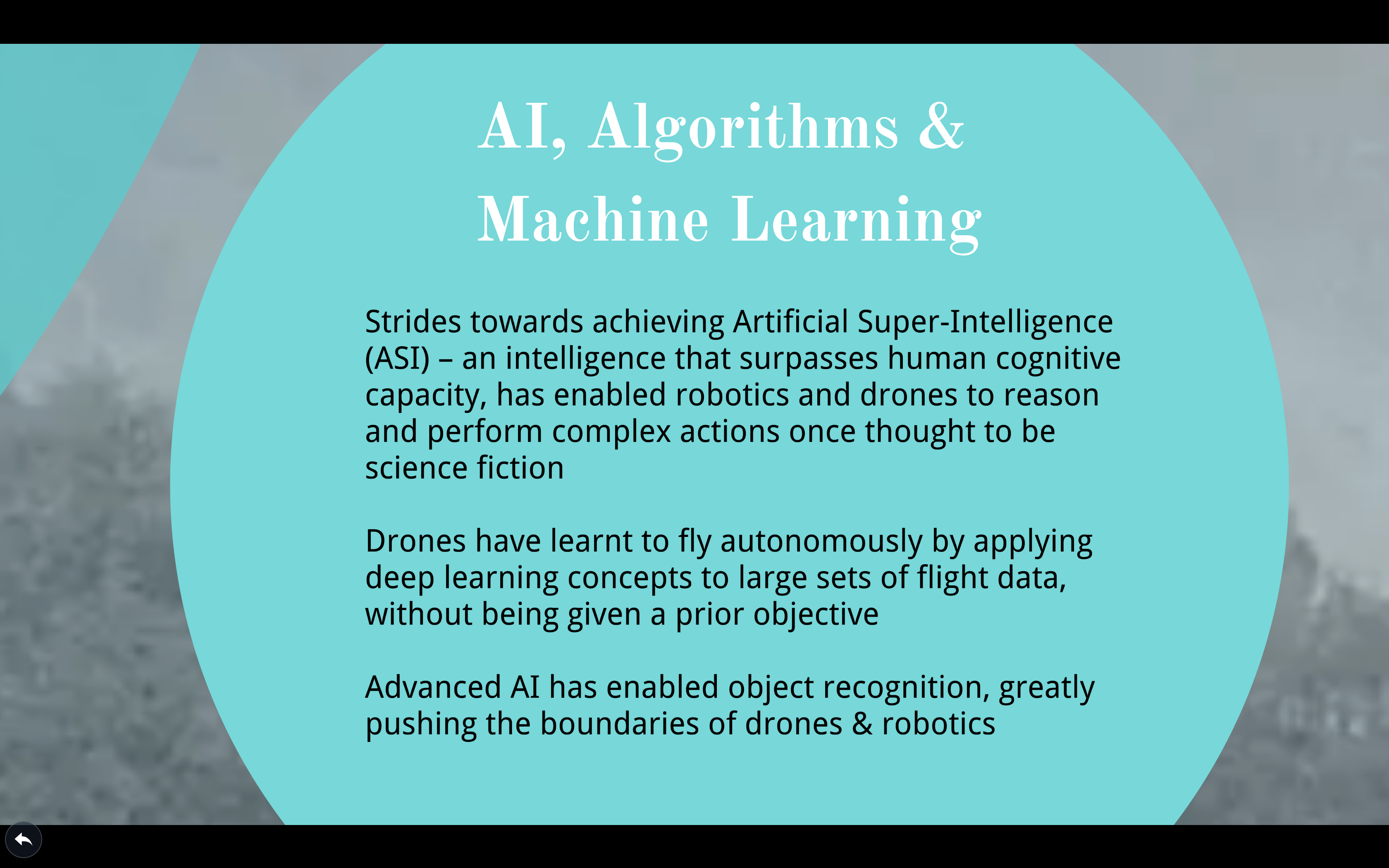
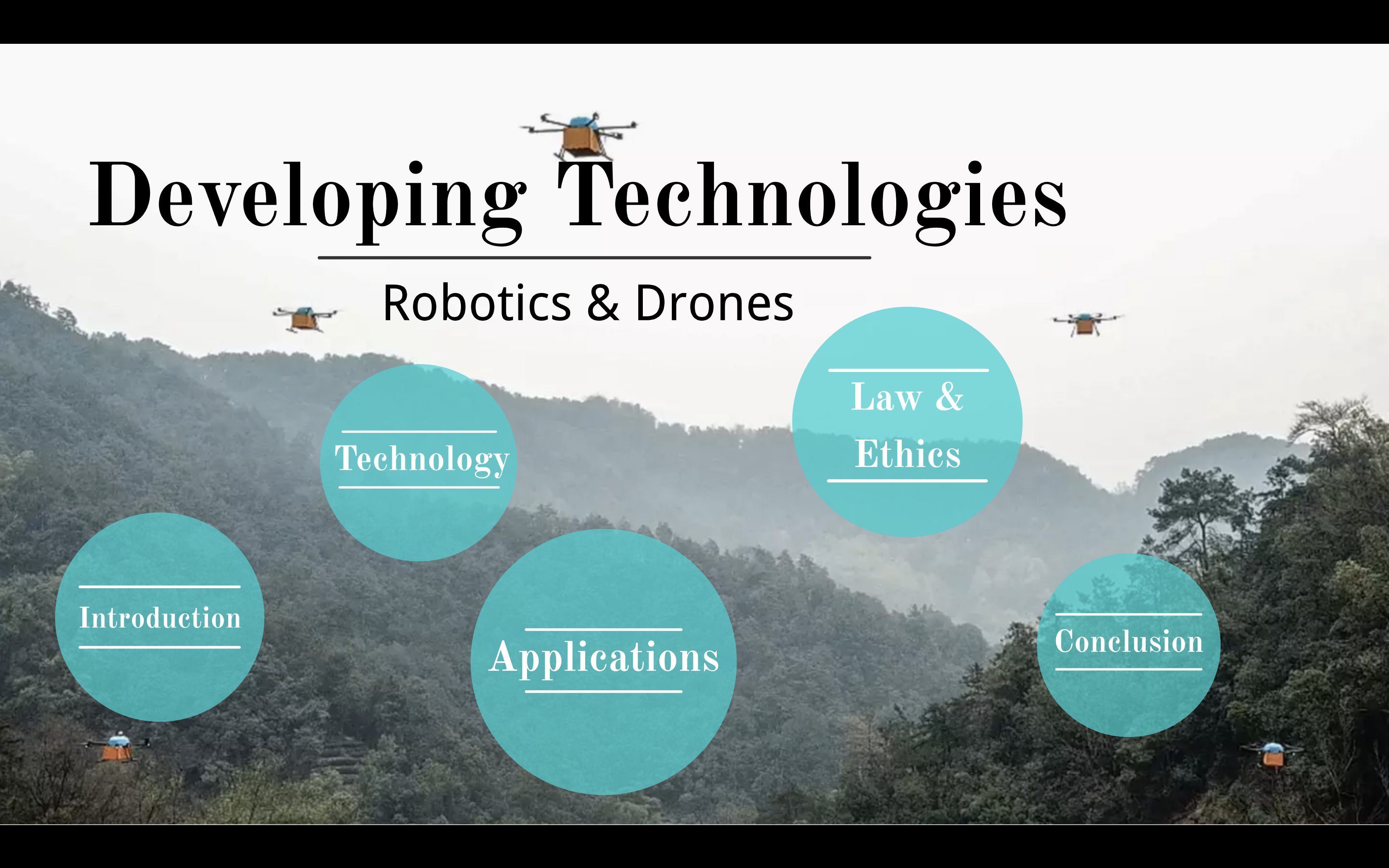
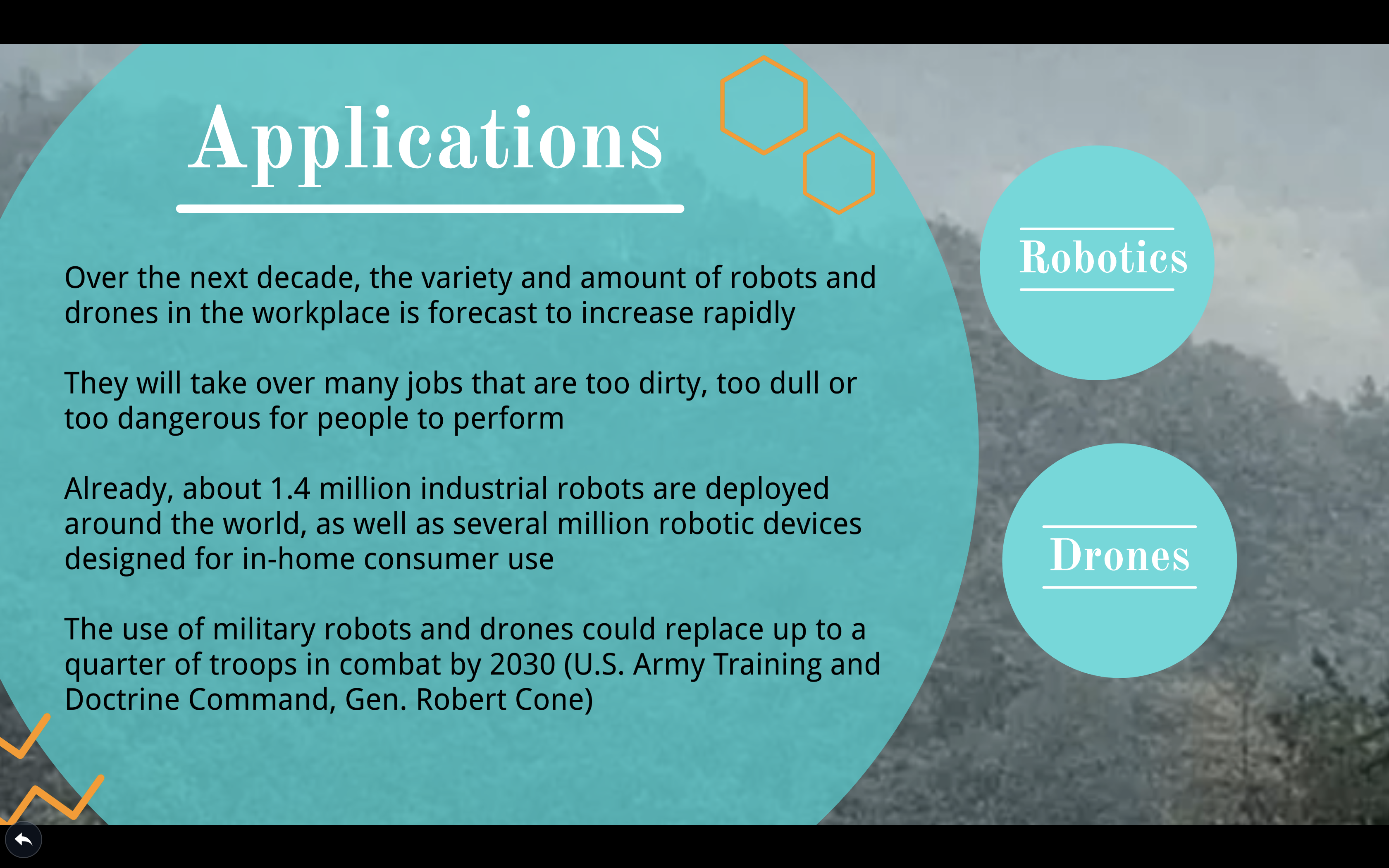
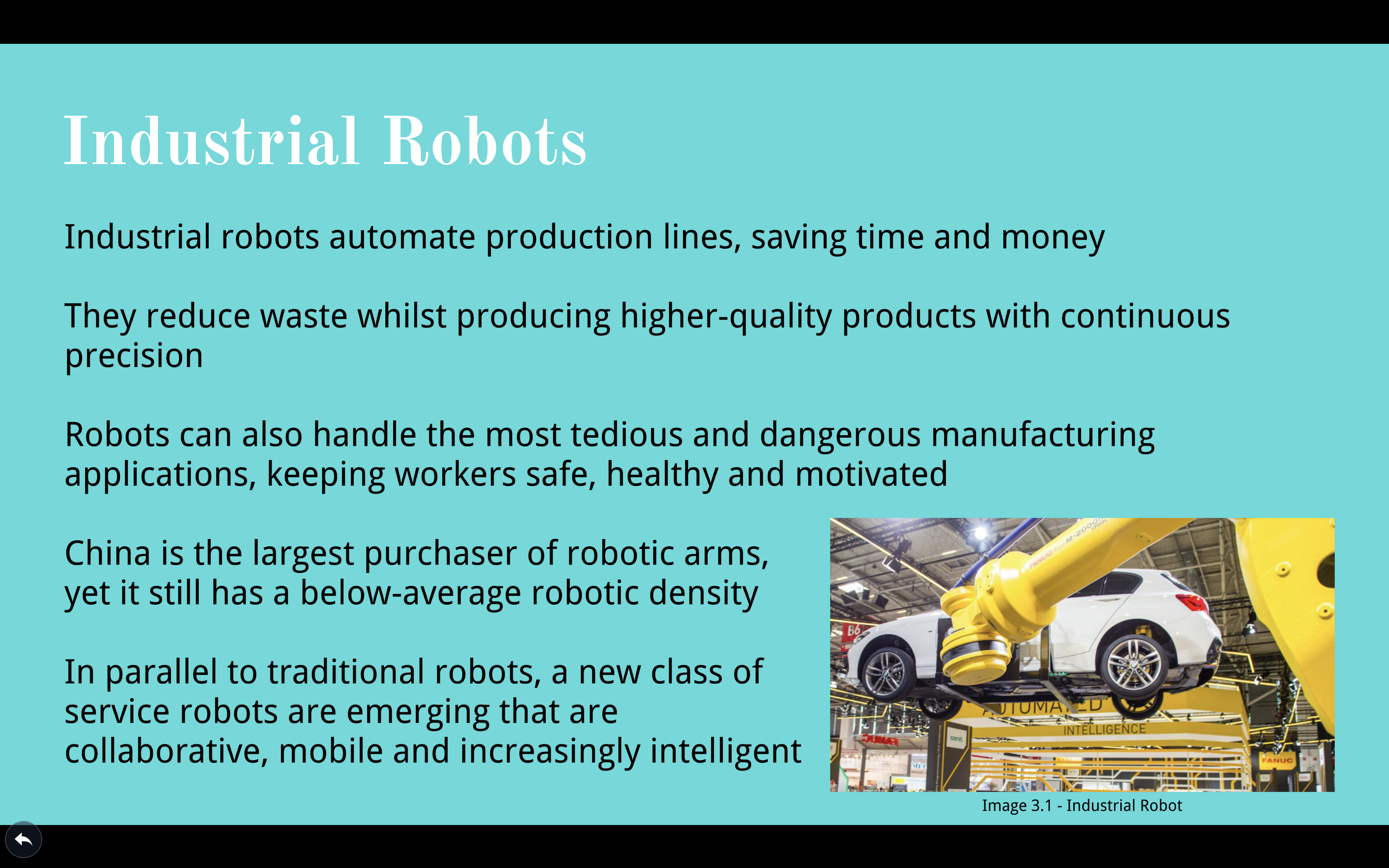
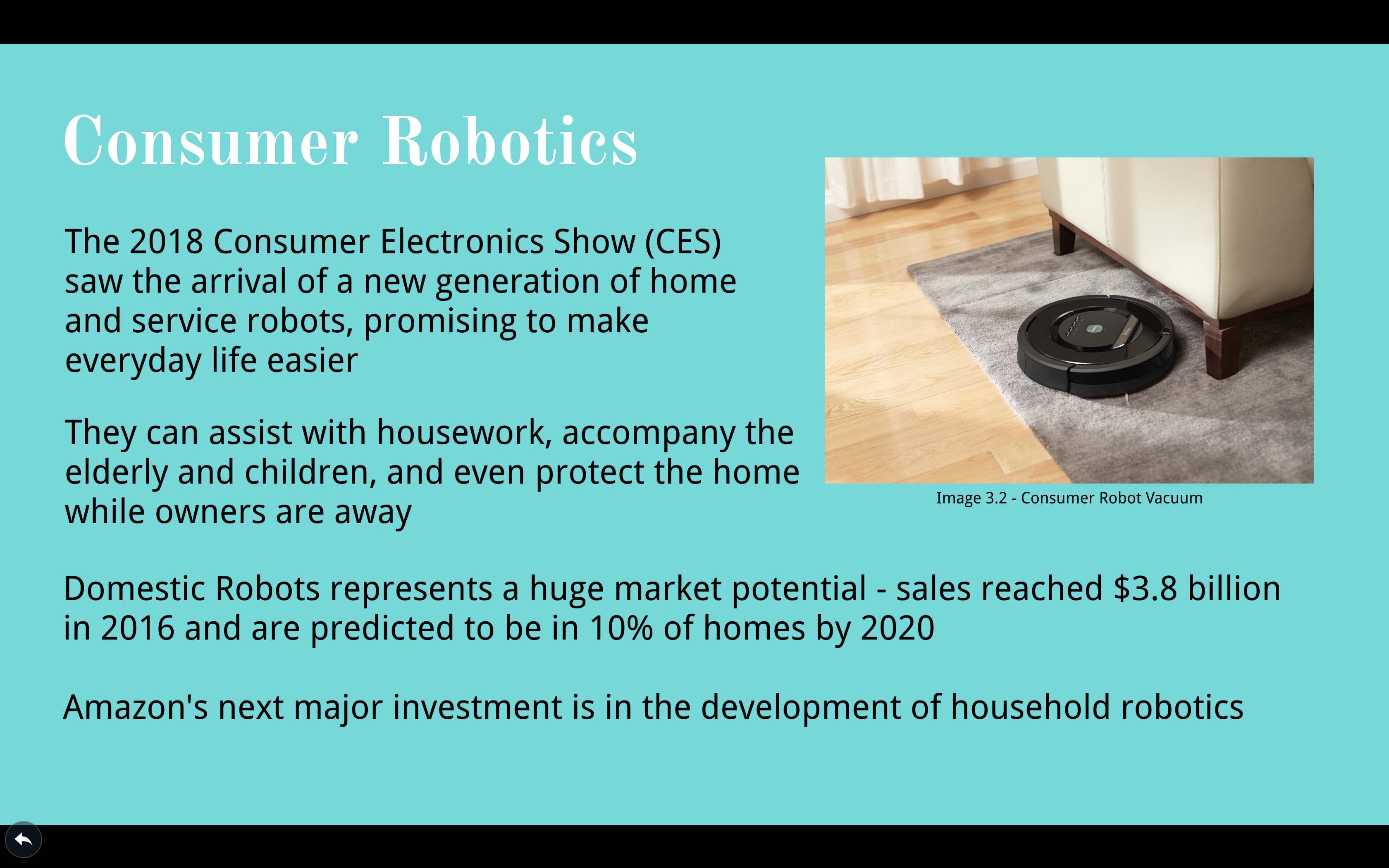
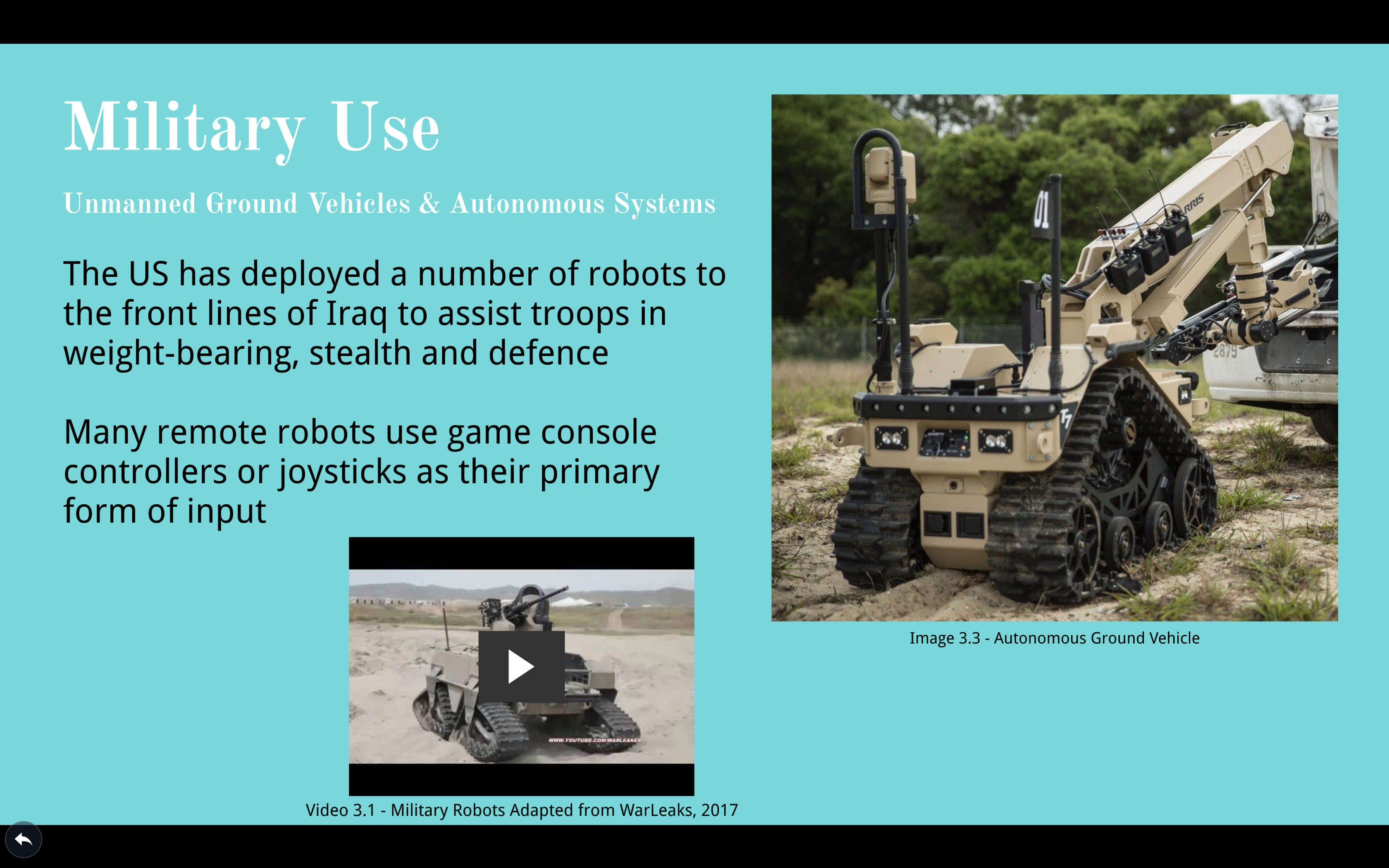
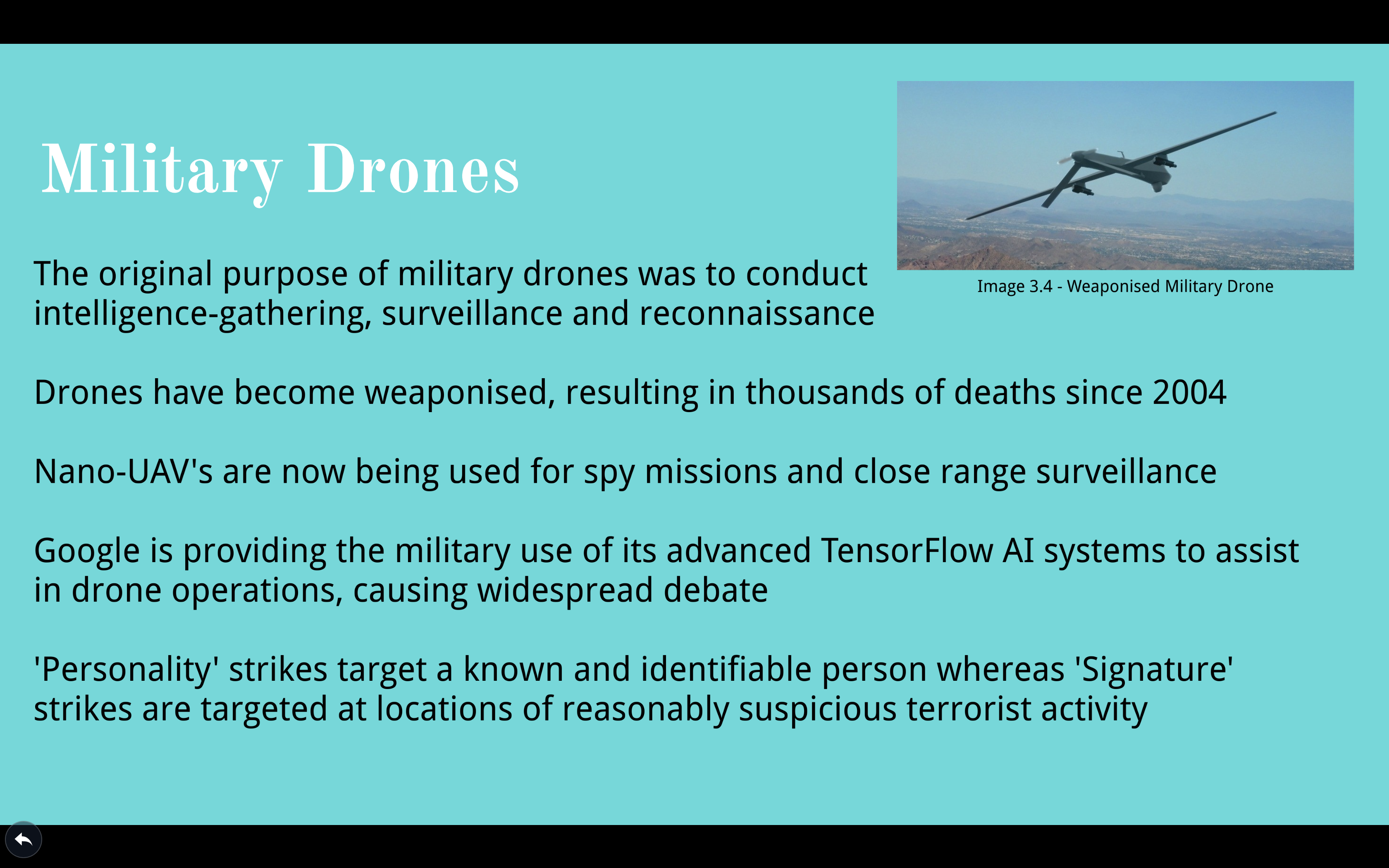

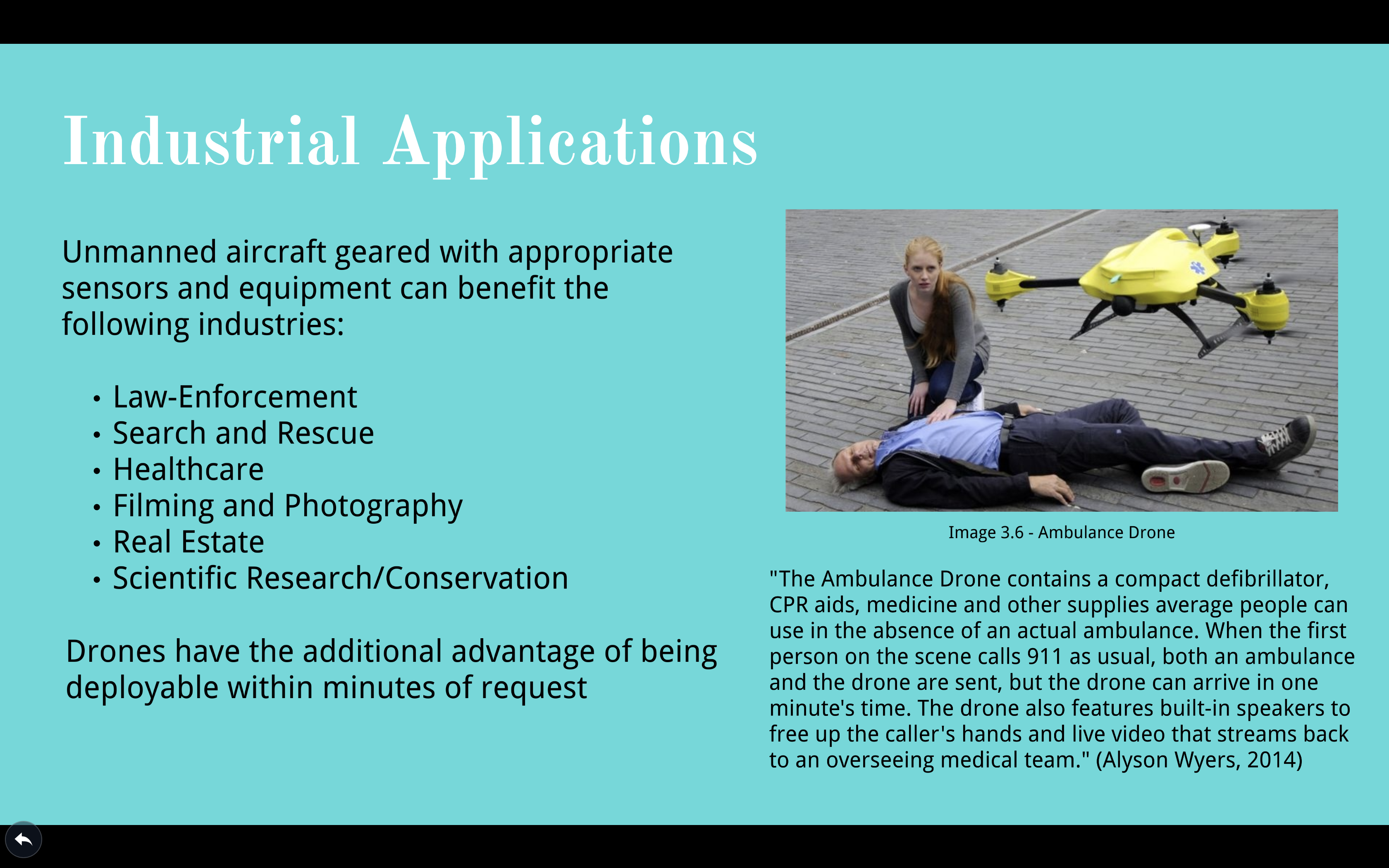
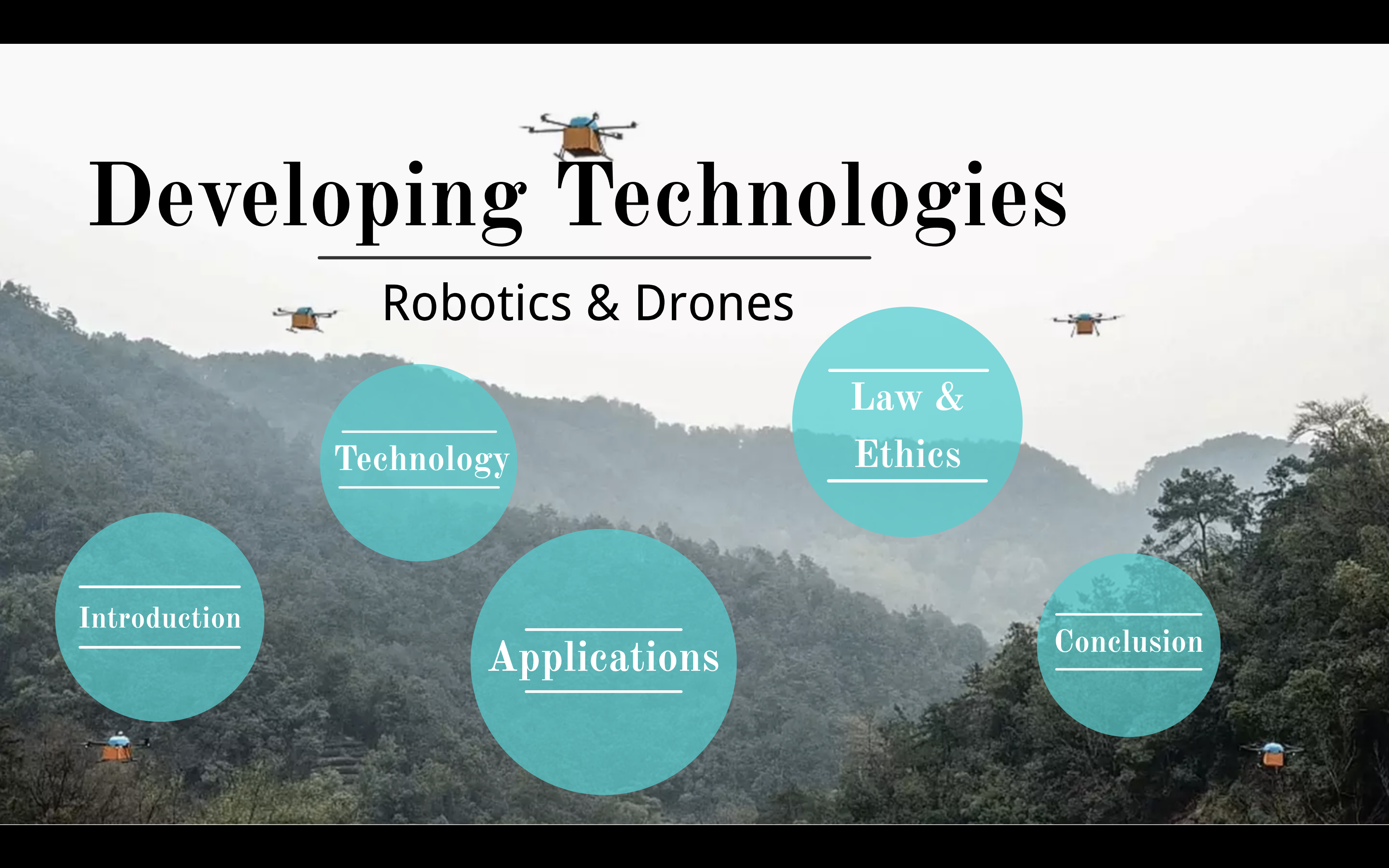
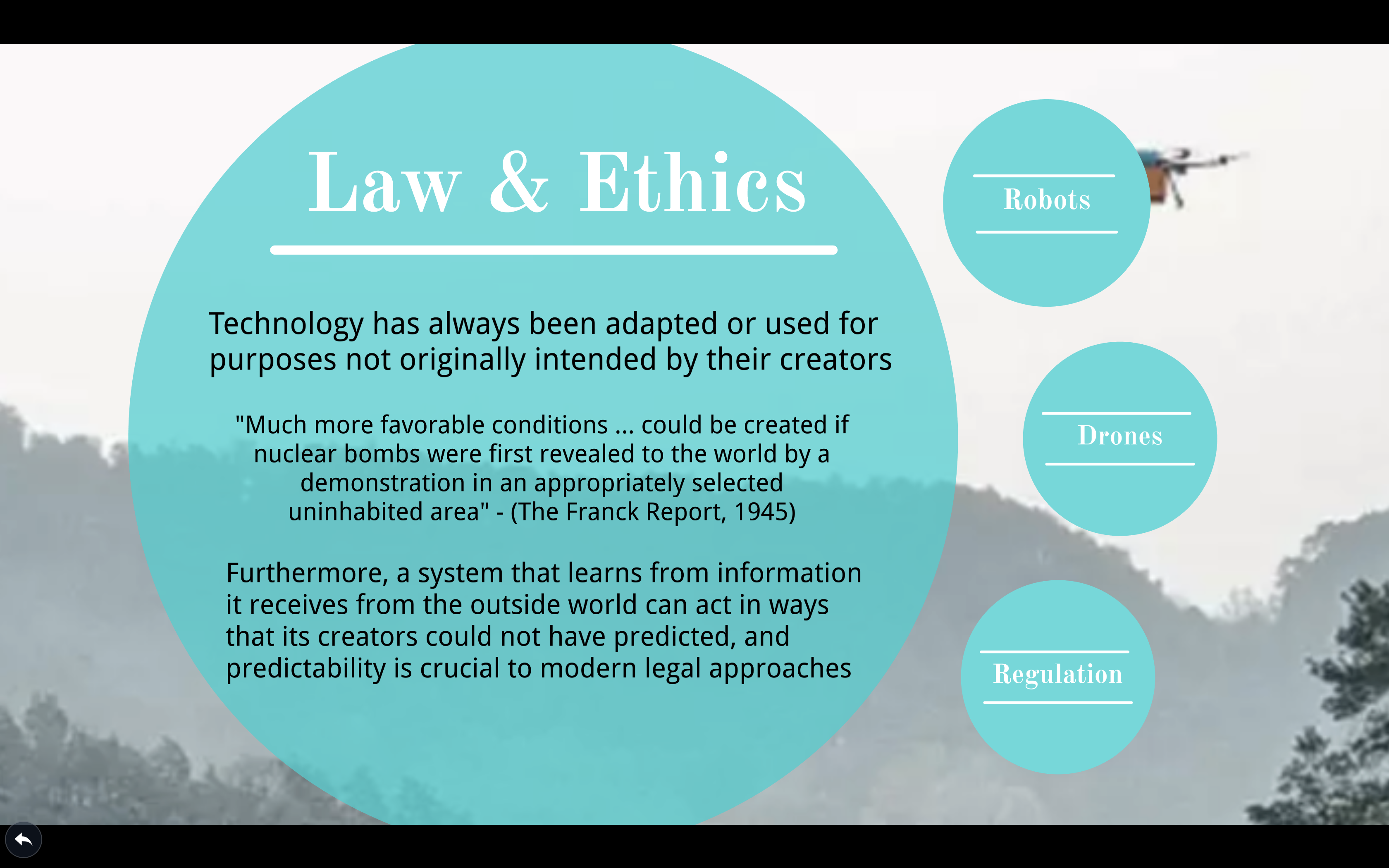
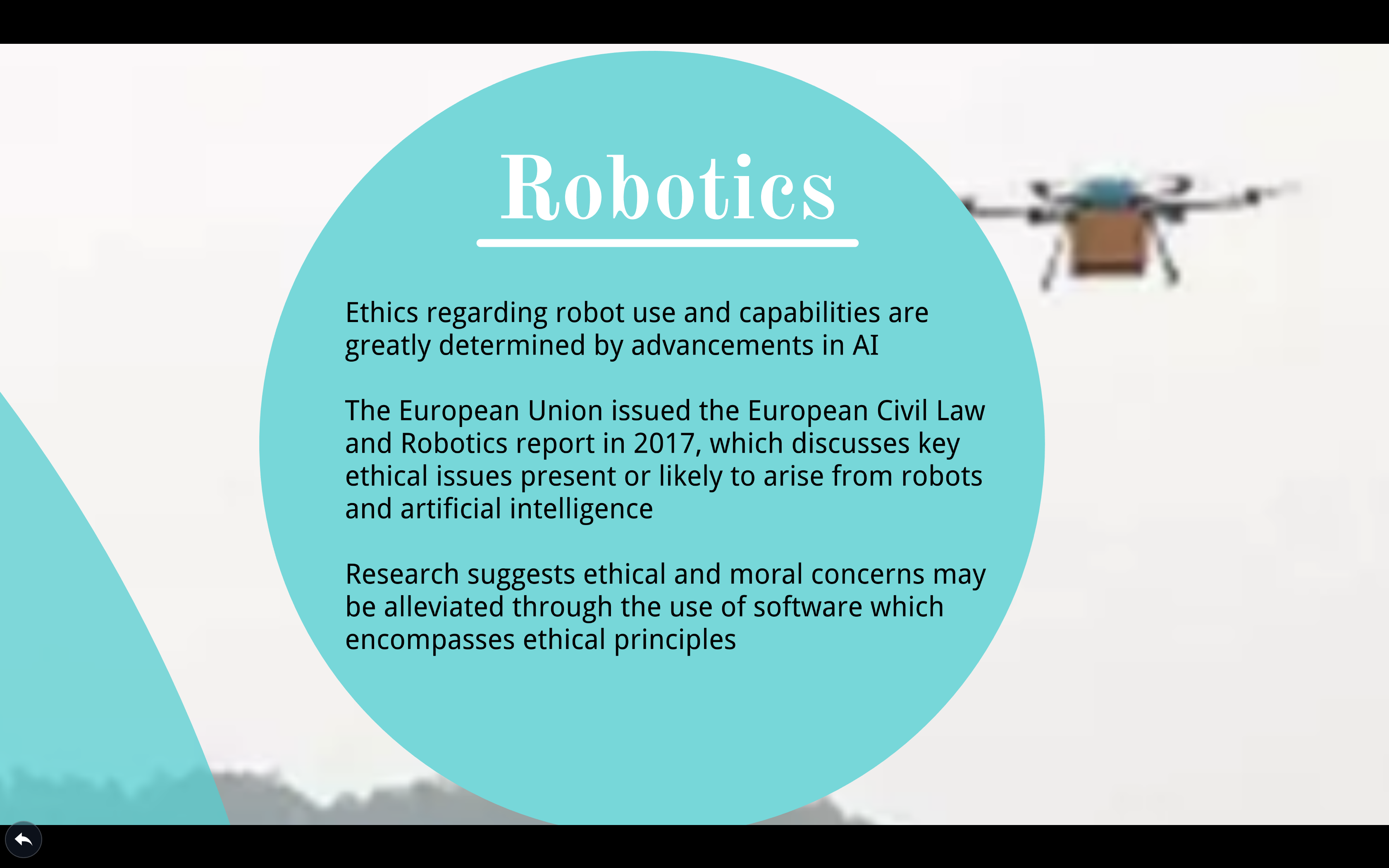
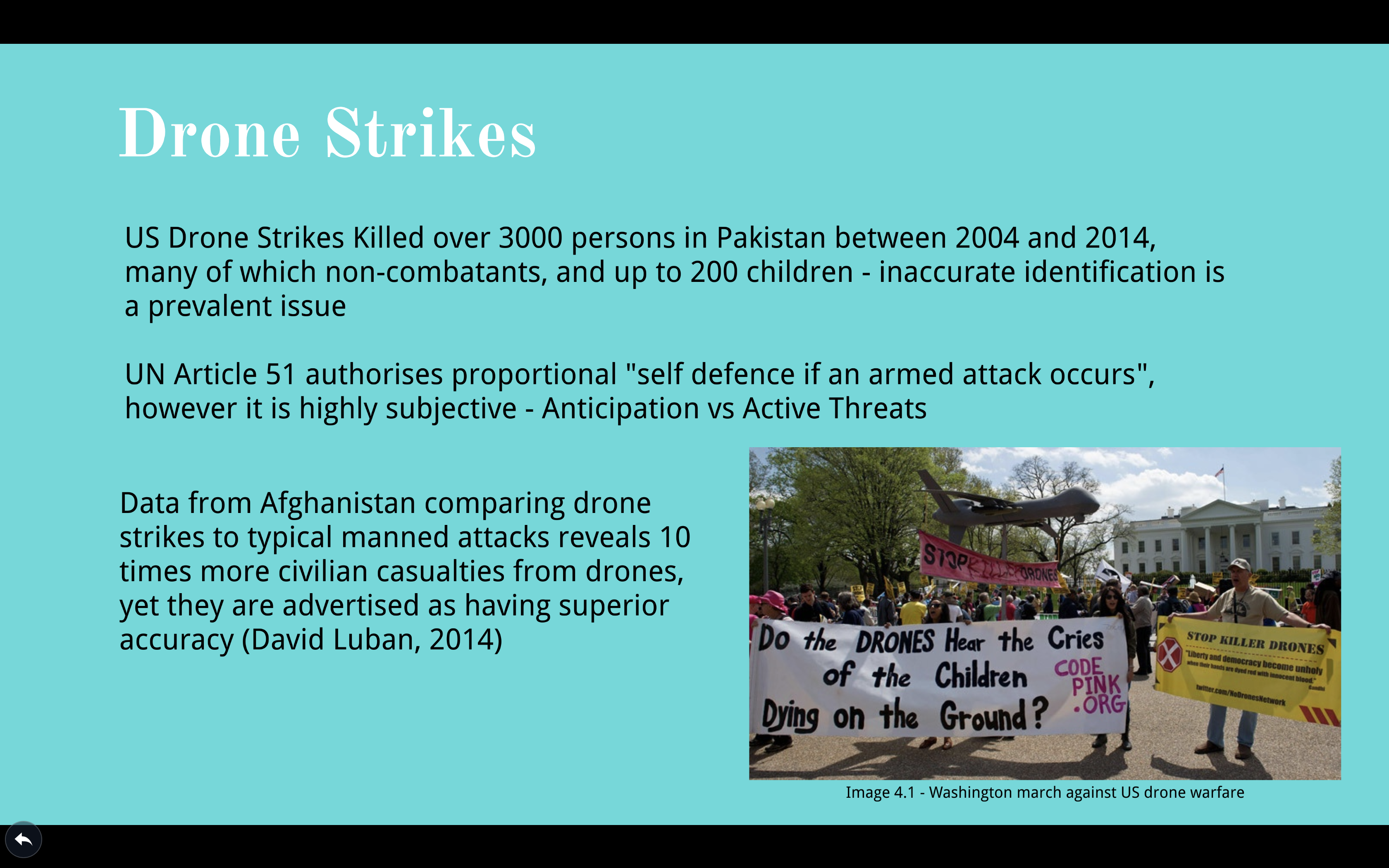
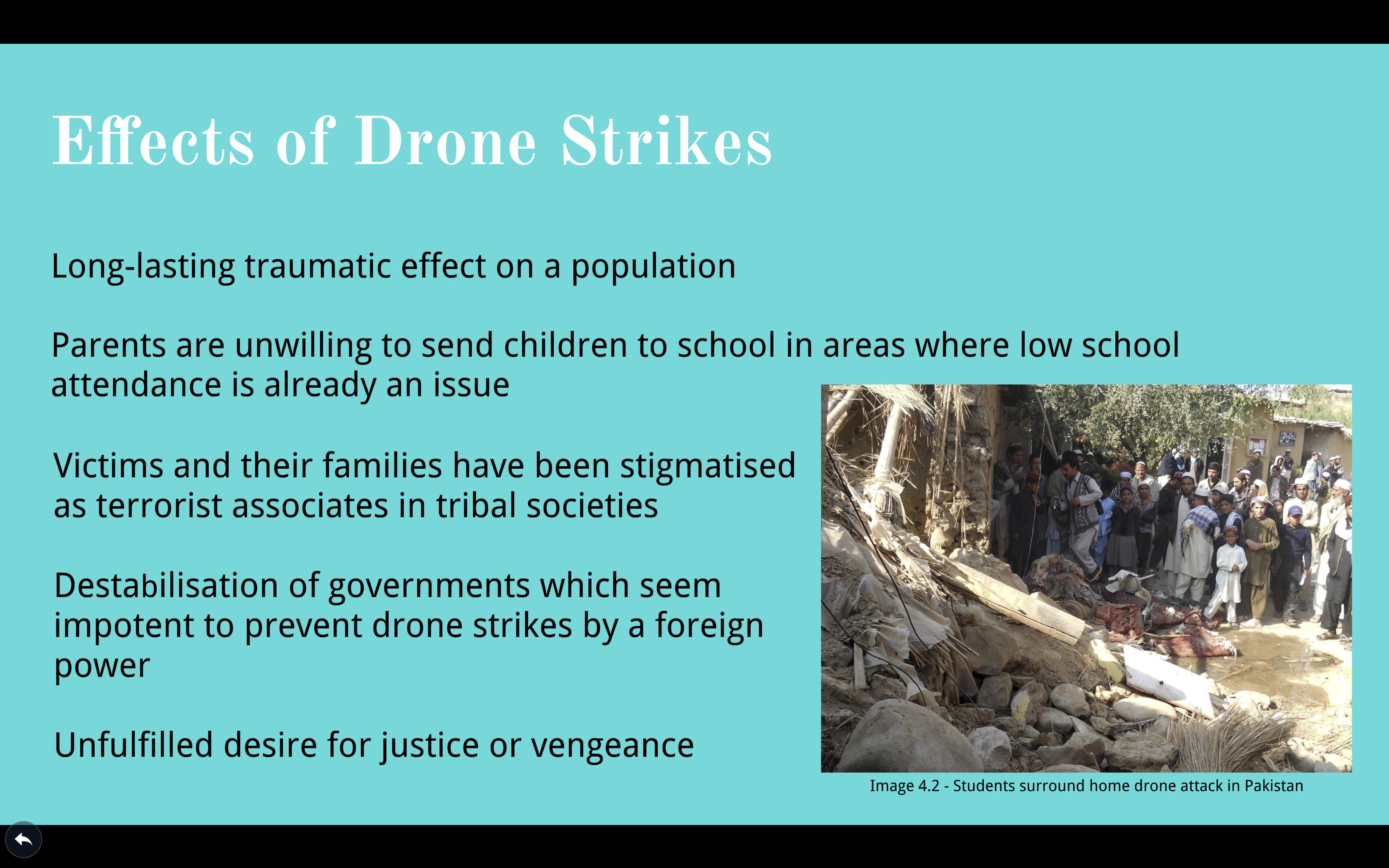
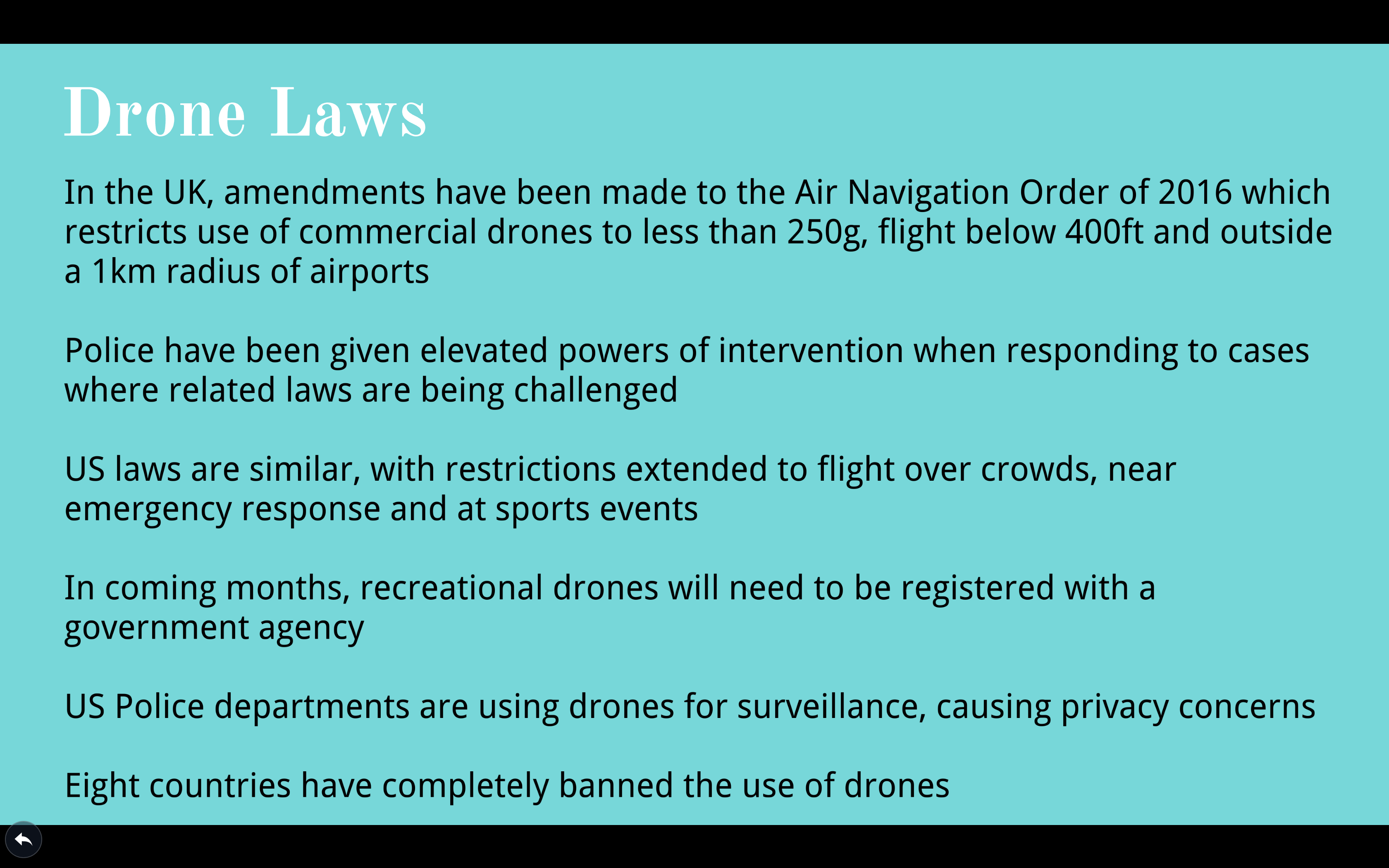

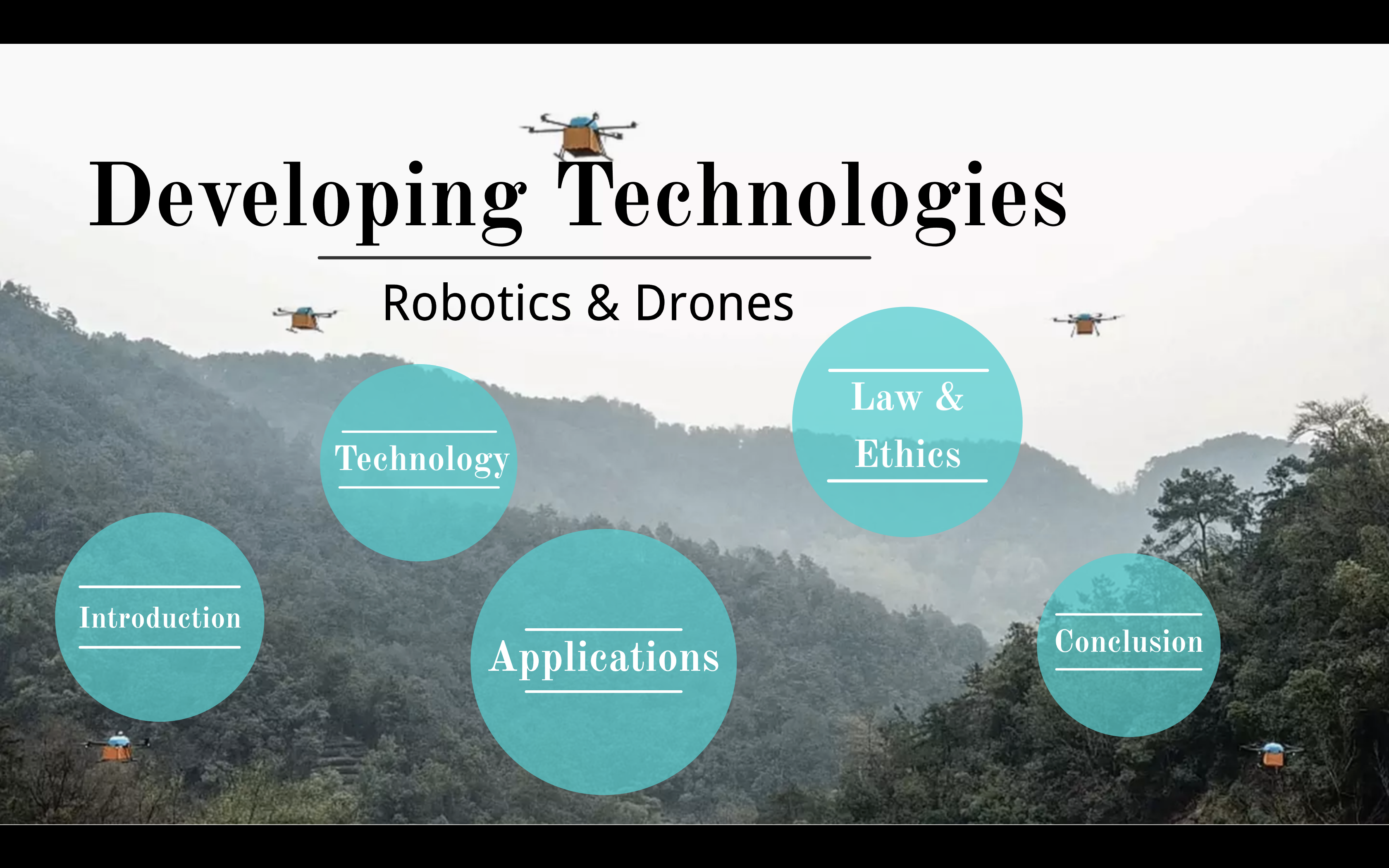
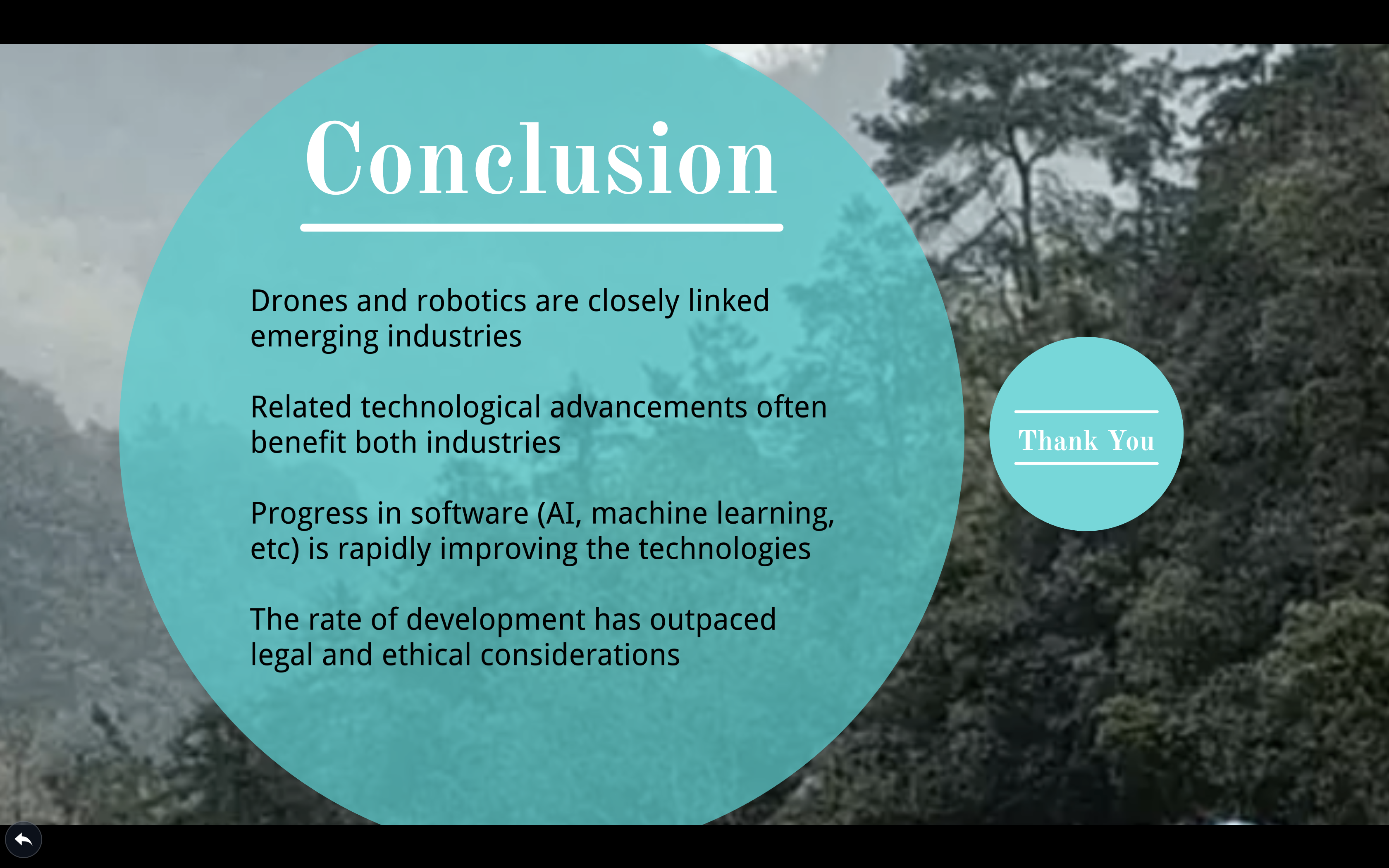


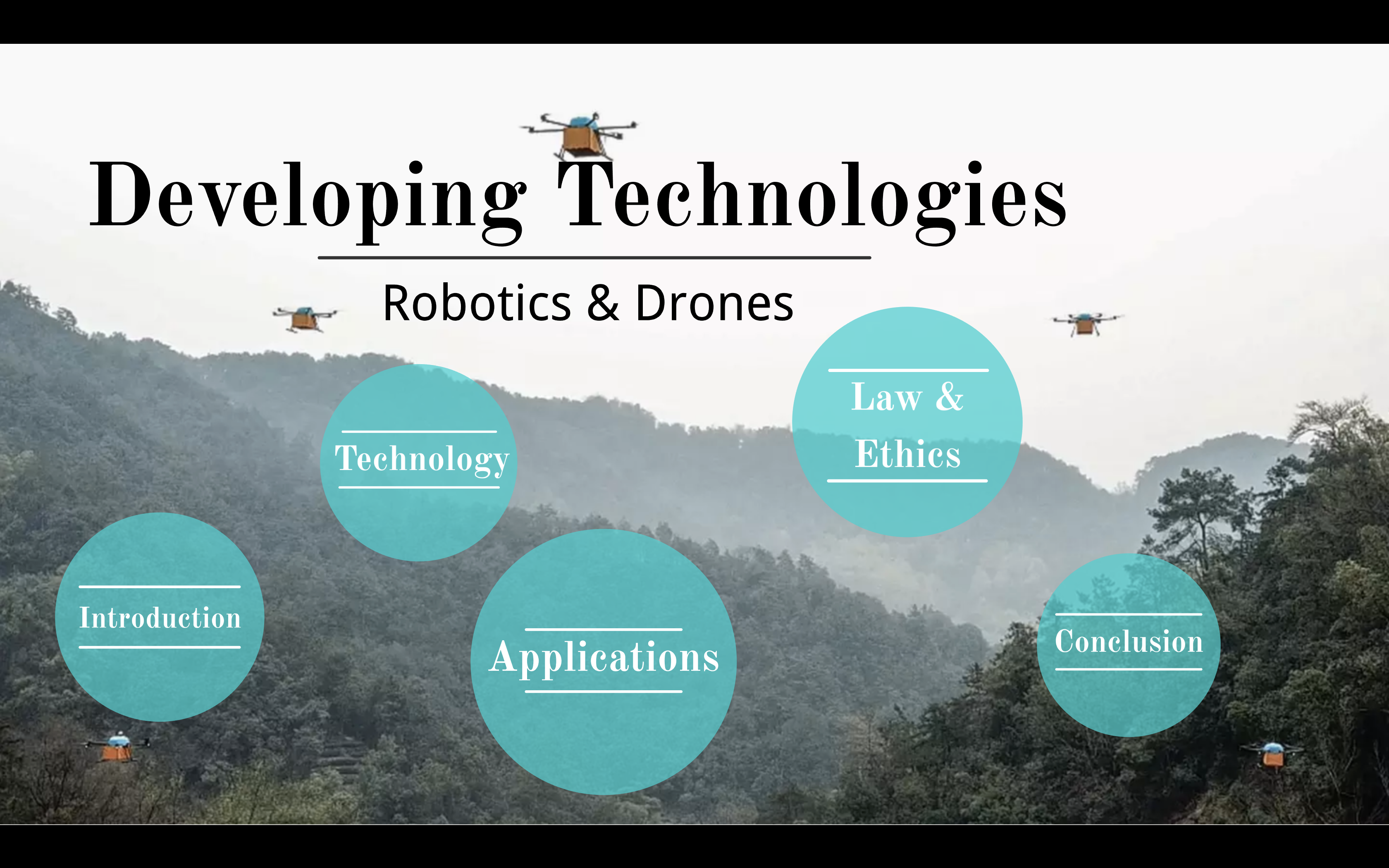
Introduction
‘Prezi' Online Presentation Link: https://prezi.com/view/epY2079X62olJSJBRyIX/
A robot can be generally classified as a man made machine, capable of performing work or actions usually carried out by humans (Idaho State Board of Education, 2014).
Drones are unmanned aircraft which may be controlled or flown autonomously, with the assistance of on-board sensors and GPS (Margaret Rouse, 2018).
Growing military and consumer markets drive research & development in both industries, and overlapping technologies accelerate advancements.
Robotics
Nicola Tesla's exhibits his radio controlled boat in 1898 (AllOnRobots, 2009).
In the 1930's, the Soviets developed a remote controlled tank (AllOnRobots, 2009).
George Devol invented the first industrial robotic arm, the Unimate, in 1954 (RobotWorx, 2016).
Developed in 1972, ’Shakey' was the first robot with the ability to perceive and reason its surroundings (SRI International, 2013).
In 1986 Honda launched a project to build a walking humanoid robot, releasing the infamous ASIMO in 2000 (Honda, 2005).
The 'da Vinci' minimally invasive surgical robot gained approval from the FDA in 2000 (Amanda Davis, 2017).
Essential Robotic Characteristics:
- Sensing
- Movement
- Energy
- Intelligence
(Galileo, 2003)
Robots automate dangerous or repetitive tasks in industries including automotive, electronic, chemical production & food processing (IDTechEx, 2018).
China's 2008 automation boom kick-started industry growth (IDTechEx, 2018).
Research & development into industrial and commercial applications is largely responsible for advancements in military robotics.
Drones
Drones were originally a military focused technology until commercial products were produced in 2006 (Luke Dormehl, 2018).
'Kettering Bug' was an unmanned aerial torpedo developed by the US in 1918. It never saw combat (Margaret Rouse, 2018).
Both the US and the USSR used military drones for spy missions during the Cold War (Justin F, 2018).
First use of modern drone warfare occurred during The Bekaa Valley War in 1982. The Israeli Air Force used drones to recon the enemy’s position, jam communications, and act as decoys that would prevent the loss of pilot life (Rebecca Grant, 2002).
US developed the first military Predator Drone in 1995, which carried out the first targeted killing of its kind on February 4, 2002. Within days of the strike, journalists on the ground were collecting accounts from local Afghans that the dead men were civilians gathering scrap metal (John Sifton, 2012).
Amazon announced delivery drones in 2014, igniting public interest (Kashyap Vyas, 2018).
Unmanned Aerial Vehicle's (UAV's) consists of the physical drone and a control system.
Main Categorisation:
- Fixed Wing
- Single Rotor
- Multi Rotor
(Shawn Herrick, 2017)
They can also be sub-categorised by size, range, endurance and purpose (Shawn Herrick, 2017).
Areas of Use Include:
- Search and rescue
- Security
- Inspections
- Science & research
- Aerial photography & video
- Surveying & gis (mapping)
- Unmanned cargo system
(Jack Brown, 2016)
Technology
Most drone and robotics research is focused on perception-centric intelligence, where devices can read and interpret data, and also then take that information and use reasoning to make decisions (Purdue University, 2018).
"Robots are becoming uncaged, mobile, collaborative and increasingly intelligent and dexterous, moving beyond their traditional strongholds to bring automation to previously inaccessible tasks" (IDTechEx, 2018).
These devices currently benefit from Artificial Narrow Intelligence (ANI), and are rapidly approaching Artificial General Intelligence (AGI).
Robots
Although robots can vary significantly in materials and design, they often share similar components.
Sensors are used to gather surrounding environmental data whilst effectors are components responsible for performing tasks.
|
Sensors |
Effectors |
|---|---|
|
Light & Vision (2D/3D) |
Grippers |
|
Proximity |
Welding Guns |
|
Acoustic |
Vacuum Cups |
|
Thermal |
Magnetic |
|
Acceleration |
Cutting Tool |
|
Collision Detection |
Drills |
|
RFID |
Screw Drivers / Spanners |
|
Tactile |
Spray Guns |
|
Torque Detection |
Sanders / Polishers |
(Samuel Bouchard, 2014), (Loop Technology, 2007)
Technologies such as the Kinect 3D for Xbox have made it feasible for rapid innovative progress to be made in robotics (Frank Tobel; Manoj Sahi, 2011).
Series Elastic Actuator technology has brought enhanced touch sensitivity to robots, enabling them to safely and efficiently interact with humans (Frank Tobel; Manoj Sahi, 2011).
Lightweight and sturdy material design has led to many innovations in robotic exoskeletons, assisting disabled persons to restore motor function, and allowing military personnel to carry heavier loads with ease (Jelor Gallego, 2016).
Drones (UAV’s)
UAV's consist of the aircraft (platform) and attachments, such as payloads or sensors (Bas Vergouw; Huub Nagel; Geert Bondt; Bart Custers, 2016).
|
Standard Platform Components |
Payloads & Sensors |
|---|---|
|
Brushless Motors |
Cameras |
|
Standard & Pusher Propellers |
Thermal |
|
Landing Gear |
Mail Parcels |
|
Electronic Speed Controllers |
Medicines |
|
On-board computer |
Fire Extinguishant |
|
Flight Controller |
Flyer Distribution |
|
Receiver & Transmitter |
Toxin Sniffers |
|
GPS Module |
Meteorological |
|
Battery |
|
|
Camera |
|
(GrindDrone, 2017), (Bas Vergouw; Huub Nagel; Geert Bondt; Bart Custers, 2016)
Swarm technology is being developed to enable autonomous collaboration between two or more drones (Andrew Masterson, 2018).
Consumer drones have seen increased popularity greatly due to their ability to capture professional photography and cinematography (Steven Flynn, 2016).
This is made possible though digital & physical image stabilisation technology, pioneered by Canon in the early 1990’s (DP Review, 2005).
Effective obstacle sensing and avoidance technology is achieved through a combination of sensors and algorithms; a necessary complementation for costly devices being flown by inexperienced persons (IDTechEx, 2018).
Software
Strides towards achieving Artificial Super-Intelligence – an intelligence that surpasses human cognitive capacity, has enabled robotics & drones to reason and perform complex actions once thought to be science fiction (Karim Jebari; Joakim Lundborg, 2018).
Drones have learnt to fly autonomously by applying deep learning concepts to large sets of flight data, without being given a prior objective (Evan Ackerman, 2017).
Advanced AI has enabled object recognition, greatly pushing the boundaries of drones & robotics.
Applications
Over the next decade, the variety and amount of robots and drones in the workplace is forecasted to increase rapidly (IDTechEx, 2018).
They will take over many jobs that are too dirty, too dull or too dangerous for people to perform. Already, about 1.4 million industrial robots are deployed around the world, as well as several million robotic devices designed for in-home consumer use. (The Kiplinger Washington Editors, 2013)
The use of military robots could replace up to a quarter of troops in combat by 2030, according to U.S. Army Training and Doctrine Command official Gen. Robert Cone (Tom Gardner, 2014), (Chris Opfer, 2014).
Robotics
Industrial
Industrial robots automate production lines, saving time and money. They reduce waste whilst producing higher-quality products with continuous precision. (RobotWorx, 2018)
Robots can also handle the most tedious and dangerous manufacturing applications, keeping workers safe, healthy and motivated (RobotWorx, 2018).
China is the largest purchaser of robotic arms, yet it has a below-average robotic density (IDTechEx, 2018). In parallel to traditional robots, a new class of service robots are emerging that are collaborative, mobile and increasingly intelligent (IDTechEx, 2018).
Consumer
The 2018 Consumer Electronics Show (CES) saw the arrival of a new generation of home and service robots, promising to make everyday life that much easier. They can assist with housework, accompany the elderly and children, and even protect the home while owners are away. (Keith Chan, 2018)
Domestic Robots represents a huge market potential - sales reached $3.8 billion in 2016 and are predicted to be in 10% of homes by 2020. (Medium, 2018), (Pablo Valerio, 2016)
Amazon's next major investment is in the development of household robotics (Mark Gurman; Brad Stone, 2018).
Military
The US has deployed a number of robots to the front lines of Iraq to assist troops in weight-bearing, stealth and defence (Ed Grabianowski, 2005).
Many robots use game console controllers or joysticks as their primary form of input. They are capable of handling input on multiple axis, and many people are already familiar with their design (Motherboard, 2015).
Drones
Military
Military drones original purpose was for intelligence gathering, surveillance and reconnaissance (DroneTechUAV, 2017).
Drones have become weaponised, resulting in thousands of deaths since 2004 (Mary Ellen O’Connell, 2010).
Nano-UAV's are now being used for spy missions and close range surveillance (Benedette Cuffari, 2018).
Google is providing the military use of its advanced TensorFlow AI systems to assist in drone operations, causing widespread debate (Samuel Gibbs, 2018).
'Personality' strikes target a known and identifiable person whereas 'Signature' strikes are targeted at locations of reasonably suspicious terrorist activity (David Luban, 2014).
Consumer
Over the last 5 years, drones have evolved from a niche hobby to a massive pro/consumer industry (IDTechEx, 2018).
The Federal Aviation Administration is expecting an average of 26% yearly growth in this sector, with estimates that 420,000 consumer drones will be in the air by 2021. (Marcus Chavers, 2018), (FAA, 2017)
Three factors led to the rapid growth of the consumer drone industry:
- Fierce competition resulted in cheaper, reliable and more capable drones
- Federal Aviation Administration was comparatively slow to introduce regulation
- Market leaders such as DJI formed quickly, forcing competition to compete by enhancing innovative software
(The Economist, 2017)
Industrial
Unmanned aircraft equipped with appropriate sensors and equipment can benefit the following industries:
- Law-Enforcement
- Search and Rescue
- Healthcare
- Filming and Photography
- Real Estate
- Scientific Research/Conservation
(Rob Nightingale, 2014)
Drones have the added advantage of being able to be deployed within minutes of request (Frank Segarra, 2018).
"The Ambulance Drone contains a compact defibrillator, CPR aids, medicine and other supplies average people can use in the absence of an actual ambulance. When the first person on the scene calls 911 as usual, both an ambulance and the drone are sent, but the drone can arrive in 1 minute's time. The drone also features built-in speakers to free up the caller's hands and live video that streams back to an overseeing medical team." (Alyson Wyers, 2014)
Law & Ethics
Technology has always been adapted or used for purposes not originally intended by their creators.
"Much more favorable conditions ... could be created if nuclear bombs were first revealed to the world by a demonstration in an appropriately selected uninhabited area" (James Franck, 1945).
Furthermore, a system that learns from information it receives from the outside world can act in ways that its creators could not have predicted, and predictability is crucial to modern legal approaches (Maksim Karliuk, 2018).
Robots
Ethics regarding robot use and capabilities are greatly determined by advancements in AI.
The European Union issued the European Civil Law and Robotics report in 2017, which discusses key ethical issues present or likely to arise from robots and artificial intelligence (European Parliament, 2016). Refer to Appendix A for a table of contents snippet referring to the aforementioned discussions.
Research suggests ethical and moral concerns may be ameliorated through the use of software which encompasses ethical principles (Robert Bogue, 2014).
Drones
Strikes
US Drone Strikes Killed over 3000 persons in Pakistan between 2004 and 2014, many of which non-combatants, and up to 200 children - inaccurate identification is a prevalent issue (Barry Kellman, 2015).
UN Article 51 authorises proportional "self defence if an armed attack occurs", however it is highly subjective - Anticipation vs Active Threats (United Nations, 2018).
Data from Afghanistan comparing drone strikes to typical manned attacks reveals 10 times more civilian casualties from drones, yet they are advertised as having superior accuracy (David Luban, 2014).
Effects of Drone Strikes
Long lasting traumatic effect on a population (Stanford International Human Rights and Conflict Resolution Clinic; Global Justice Clinic (GJC) at NYU School of Law, 2012).
Parents are unwilling to send children to school in areas where low school attendance is already an issue (Stanford International Human Rights and Conflict Resolution Clinic; Global Justice Clinic (GJC) at NYU School of Law, 2012).
Victims and their families have been stigmatised as terrorist associates in tribal societies.
Destabilisation of governments which seem impotent to prevent drone strikes by a foreign power (David Luban, 2014).
Unfulfilled desire for justice or vengeance. "We are a people who wait 100 years to exact revenge. We never forgive our enemy," the Pakistani Tribal leaders said in a statement. (BBC News, 2011), (Rooj Alwazir, 2014)
Laws
In the UK, amendments have been made to the Air Navigation Order of 2016 which restrict use of commercial drones to less than 250g, flight below 400ft and outside a 1km radius of airports. Police have been given elevated powers of intervention when responding to cases where related laws are being challenged. (David Atkinson, 2018)
US laws are similar, with restrictions extended to flight over crowds, near emergency response and at sports events. In coming months, recreational drones will need to be registered with a government agency. (Maggie Tillman, 2018)
US Police departments are using drones for surveillance, causing privacy concerns (Michael Sisitzky; Simon McCormack, 2018).
Eight countries have completely banned the use of drones: Argentina, Barbados, Cuba, India, Morocco, Saudi Arabia, Slovenia, and Uzbekistan (Therese Jones, 2017).
Conclusion
Drones and robotics are closely linked emerging industries with related technological advancements often benefiting both industries. Progress in software (AI, machine learning, etc) is rapidly improving the technologies such that the rate of development has outpaced ethical and legal considerations.
References
- Idaho State Board of Education (2014). Robotics: Facts. Available at: http://idahoptv.org/sciencetrek/topics/robots/facts.cfm Accessed on December 6th, 2018
- Margaret Rouse (2018). drone (unmanned aerial vehicle, UAV). Available at: https://internetofthingsagenda.techtarget.com/definition/drone Accessed on December 6th, 2018
- AllOnRobots (2009). The history of military robots. Available at: http://www.allonrobots.com/military_robots_history.html Accessed on December 6th, 2018
- RobotWorx (2016). Industrial Robot History. Available at: https://www.robots.com/articles/industrial-robot-history Accessed on December 6th, 2018
- SRI International (2013). Shakey the Robot. Available at: https://www.sri.com/work/timeline-innovation/timeline.php?timeline=computing-digital#!&innovation=shakey-the-robot Accessed on December 6th, 2018
- Honda (2005). History of ASIMO. Available at: http://asimo.honda.com/asimo-history/ Accessed on December 6th, 2018
- Amanda Davis (2017). Timeline: The Rise of Robots. Available at: http://theinstitute.ieee.org/tech-history/technology-history/timeline-the-rise-of-robots Accessed on December 6th, 2018
- Galileo (2003). Introduction To Robots. Available at: http://www.galileo.org/robotics/intro.html Accessed on December 6th, 2018
- IDTechEx (2018). New Robotics and Drones 2018-2038: Technologies, Forecasts, Players. Available at: https://www.idtechex.com/research/reports/new-robotics-and-drones-2018-2038-technologies-forecasts-players-000584.asp Accessed on December 6th, 2018
- Luke Dormehl (2018). The history of drones in 10 milestones. Available at: https://www.digitaltrends.com/cool-tech/history-of-drones/ Accessed on December 6th, 2018
- Justin F (2018). The History Of Drones (Drone History Timeline From 1849 To 2018). Available at: https://www.dronethusiast.com/history-of-drones/ Accessed on December 6th, 2018
- Rebecca Grant (2002). The Bekaa Valley War. Available at: http://www.airforcemag.com/MagazineArchive/Pages/2002/June%202002/0602bekaa.aspx Accessed on December 6th, 2018
- John Sifton (2012). A Brief History of Drones. Available at: https://www.thenation.com/article/brief-history-drones/ Accessed on December 6th, 2018
- Kashyap Vyas (2018). A Brief History of Drones: The Remote Controlled Unmanned Aerial Vehicles (UAVs). Available at: https://interestingengineering.com/a-brief-history-of-drones-the-remote-controlled-unmanned-aerial-vehicles-uavs Accessed on December 6th, 2018
- Shawn Herrick (2017). The three main categories of drones and their advantages and disadvantages. Available at: https://botlink.com/blog/the-3-main-categories-of-drones-and-their-advantages-and-disadvantages Accessed on December 6th, 2018
- Jack Brown (2016). What is a drone? Main features & applications of today’s drones. Available at: http://mydronelab.com/blog/what-is-a-drone.html Accessed on December 6th, 2018
- Purdue University (2018). AI-based research toward autonomous robots and drones. Available at: https://phys.org/news/2018-09-ai-based-autonomous-robots-drones.html Accessed on December 7th, 2018
- Loop Technology (2007). End Effectors for Robots. Available at: http://www.looptechnology.com/robot-end-effector-types.asp#.XA7E3BP7R25 Accessed on December 7th, 2018
- Samuel Bouchard (2014). 7 Types of Industrial Robot Sensors. Available at: https://blog.robotiq.com/bid/72633/7-Types-of-Industrial-Robot-Sensors Accessed on December 7th, 2018
- Frank Tobel; Manoj Sahi (2011). Recent Breakthroughs Are Enabling Consumer and Low-cost Commercial Robots. Available at: https://www.therobotreport.com/recent-breakthroughs-are-enabling-consumer-and-low-cost-commercial-robots/ Accessed on December 7th, 2018
- Jelor Gallego (2016). New Super-Light Exoskeleton Created to Enhance The Human Body. Available at: https://futurism.com/new-super-light-exoskeleton-created-to-enhance-the-human-body Accessed on December 7th, 2018
- Bas Vergouw; Huub Nagel; Geert Bondt; Bart Custers (2016). Drone Technology: Types, Payloads, Applications, Frequency Spectrum Issues and Future Developments. Available at: https://www.springer.com/cda/content/document/cda_downloaddocument/9789462651319-c2.pdf?SGWID=0-0-45-1592404-p180146657 Accessed on December 7th, 2018
- GrindDrone (2017). Drone Components Quick List of it’s Parts. Available at: http://grinddrone.com/drone-features/drone-components Accessed on December 7th, 2018
- Andrew Masterson (2018). Autonomous and cooperating: the dawn of the drone swarm. Available at: https://cosmosmagazine.com/technology/autonomous-and-cooperating-the-dawn-of-the-drone-swarm Accessed on December 7th, 2018
- Steven Flynn (2016). Drones In Movies: 7 Hollywood Movies Filmed With Drones. Available at: https://skytango.com/drones-in-movies-7-hollywood-movies-filmed-with-drones/ Accessed on December 7th, 2018
- DP Review (2005). A brief history of image stabilization technologies. Available at: https://www.dpreview.com/forums/post/14895213 Accessed on December 7th, 2018
- Karim Jebari; Joakim Lundborg (2018). The intelligence explosion revisited. Available at: https://www.emeraldinsight.com/doi/pdfplus/10.1108/FS-04-2018-0042 Accessed on December 7th, 2018
- Evan Ackerman (2017). Drone Uses AI and 11,500 Crashes to Learn How to Fly. Available at: https://spectrum.ieee.org/automaton/robotics/drones/drone-uses-ai-and-11500-crashes-to-learn-how-to-fly Accessed on December 7th, 2018
- The Kiplinger Washington Editors (2013). 6 Fields Where Robots Are Taking Charge. Available at: https://www.kiplinger.com/slideshow/business/T057-S005-robots-taking-charge/index.html Accessed on December 8th, 2018
- Tom Gardner (2014). Rise of the machines: Robots may replace a QUARTER of U.S. combat troops by 2030, claims general. Available at: https://www.dailymail.co.uk/news/article-2546750/Robots-replace-QUARTER-Of-U-S-Combat-Soldiers-By-2030-claims-general.html Accessed on December 8th, 2018
- Chris Opfer (2014). Are robots replacing human soldiers?. Available at: https://science.howstuffworks.com/robots-replacing-soldiers.htm Accessed on December 8th, 2018
- RobotWorx (2018). How Can Industrial Robots Improve My Profits?. Available at: https://www.robots.com/faq/how-can-industrial-robots-improve-my-profits Accessed on December 8th, 2018
- RobotWorx (2018). Industrial Robot Applications. Available at: https://www.robots.com/applications Accessed on December 8th, 2018
- Keith Chan (2018). 5 best robots to serve the family unveiled at CES 2018. Available at: https://www.scmp.com/magazines/style/tech-design/article/2129689/5-best-robots-serve-family-unveiled-ces-2018 Accessed on December 8th, 2018
- Medium (2018). What about the consumer robotics revolution we are experiencing today?. Available at: https://medium.com/@northof41/what-about-the-consumer-robotics-revolution-we-are-experiencing-today-1e271188b45c Accessed on December 8th, 2018
- Pablo Valerio (2016). Consumer Robots in 10% of Homes by 2020. Available at: https://www.eetimes.com/author.asp?section_id=36&doc_id=1329173 Accessed on December 8th, 2018
- Mark Gurman; Brad Stone (2018). Amazon's Next Secret Project Could Be Robots That Follow You Around. Available at: http://time.com/5250356/amazon-home-robots/ Accessed on December 8th, 2018
- Ed Grabianowski (2005). How Military Robots Work. Available at: https://science.howstuffworks.com/military-robot.htm Accessed on December 8th, 2018
- Motherboard (2015). The Dawn of Killer Robots (Full Length). Available at: https://www.youtube.com/watch?v=5qBjFZV19p0 Accessed on December 8th, 2018
- DroneTechUAV (2017). Military Unmanned Aerial Vehicle Solutions. Available at: http://www.dronetechuav.com/military-applications.html# Accessed on December 8th, 2018
- Mary Ellen O’Connell (2010). Unlawful Killing with Combat Drones A Case Study of Pakistan, 2004-2009. Available at: https://www.law.upenn.edu/institutes/cerl/conferences/targetedkilling/papers/OConnellDrones.pdf Accessed on December 8th, 2018
- Benedette Cuffari (2018). NanoUAVs for Military Applications. Available at: https://www.azonano.com/article.aspx?ArticleID=4987 Accessed on December 8th, 2018
- Samuel Gibbs (2018). Google’s AI is being used by US military drone programme. Available at: https://www.theguardian.com/technology/2018/mar/07/google-ai-us-department-of-defense-military-drone-project-maven-tensorflow Accessed on December 8th, 2018
- David Luban (2014). Drones, Morality and International Law. Available at: https://www.youtube.com/watch?v=niHVNeP04tw Accessed on December 8th, 2018
- IDTechEx (2018). Drones 2018-2038: Components, Technologies, Roadmaps, Market Forecasts. Available at: https://www.idtechex.com/research/reports/drones-2018-2038-components-technologies-roadmaps-market-forecasts-000631.asp Accessed on December 8th, 2018
- Marcus Chavers (2018). Consumer Drones By the Numbers in 2018 and Beyond. Available at: https://www.newsledge.com/consumer-drones-2018-numbers/ Accessed on December 8th, 2018
- FAA (2017). FAA Aerospace Forecast Fiscal Years 2017-2037. Available at: https://www.faa.gov/data_research/aviation/aerospace_forecasts/media/FY2017-37_FAA_Aerospace_Forecast.pdf Accessed on December 8th, 2018
- The Economist (2017). Taking flight: Civilian Drones. Available at: https://www.economist.com/technology-quarterly/2017-06-08/civilian-drones Accessed on December 8th, 2018
- Rob Nightingale (2014). 7 Industries Drones Are Set to Revolutionize. Available at: https://www.makeuseof.com/tag/7-industries-drones-set-revolutionize/ Accessed on December 8th, 2018
- Frank Segarra (2018). 10 Benefits of Drone-Based Asset Inspections. Available at: https://www.techzone360.com/topics/techzone/articles/2018/01/15/436413-10-benefits-drone-based-asset-inspections.htm Accessed on December 8th, 2018
- Alyson Wyers (2014). The Ambulance Drone Sends First Aid Supplies Quickly to the Scene. Available at: https://www.trendhunter.com/trends/ambulance-drone Accessed on December 8th, 2018
- James Franck (1945). Report of the Committee on Political and Social Problems (The Franck Report). U.S. National Archives, Record Group 77, Records of the Chief of Engineers, Manhattan Engineer District, Harrison-Bundy File, folder #76. Available at: http://www.dannen.com/decision/franck.html Accessed on December 9th, 2018
- Maksim Karliuk (2018). The Ethical and Legal Issues of Artificial Intelligence. Available at: https://moderndiplomacy.eu/2018/04/24/the-ethical-and-legal-issues-of-artificial-intelligence/ Accessed on December 9th, 2018
- European Parliament (2016). EUROPEAN CIVIL LAW RULES IN ROBOTICS. Available at: http://www.europarl.europa.eu/RegData/etudes/STUD/2016/571379/IPOL_STU(2016)571379_EN.pdf Accessed on December 9th, 2018
- Robert Bogue (2014). Robot ethics and law. Available at: https://www.emeraldinsight.com/doi/abs/10.1108/IR-04-2014-0328 Accessed on December 9th, 2018
- Barry Kellman (2015). Exporting Armed Drones – The United States Sets Policy. Available at: https://www.asil.org/insights/volume/19/issue/17/exporting-armed-drones-%E2%80%93-united-states-sets-policy Accessed on December 9th, 2018
- United Nations (2018). CHAPTER VII: ACTION WITH RESPECT TO THREATS TO THE PEACE, BREACHES OF THE PEACE, AND ACTS OF AGGRESSION. Available at: http://www.un.org/en/sections/un-charter/chapter-vii/ Accessed on December 9th, 2018
- Stanford International Human Rights and Conflict Resolution Clinic; Global Justice Clinic (GJC) at NYU School of Law (2012). Living&Under&Drones Death, Injury, and Trauma to Civilians From US Drone Practices in Pakistan. Available at: https://www-cdn.law.stanford.edu/wp-content/uploads/2015/07/Stanford-NYU-LIVING-UNDER-DRONES.pdf Accessed on December 9th, 2018
- BBC News (2011). Pakistan: Calls for revenge after US drones kill 40. Available at: https://www.bbc.co.uk/news/world-south-asia-12784675 Accessed on December 9th, 2018
- Rooj Alwazir (2014). Yemenis seek justice in wedding drone strike. Available at: https://www.aljazeera.com/indepth/features/2014/01/yemenis-seek-justice-wedding-drone-strike-201418135352298935.html Accessed on December 9th, 2018
- David Atkinson (2018). New UK Drone Laws Announced. Available at: https://www.heliguy.com/blog/2018/07/20/new-uk-drone-laws-announced/ Accessed on December 9th, 2018
- Maggie Tillman (2018). Drone flying in the UK and US: All the rules and regulations explained. Available at: https://www.pocket-lint.com/drones/news/141667-drone-regulations-and-rules-the-drone-laws-you-need-to-know-before-flying-in-uk-and-us Accessed on December 9th, 2018
- Michael Sisitzky; Simon McCormack (2018). New NYPD Drone Policy Represents a Serious Threat to Privacy. Available at: https://www.aclu.org/blog/privacy-technology/surveillance-technologies/new-nypd-drone-policy-represents-serious-threat Accessed on December 9th, 2018
- Therese Jones (2017). International Commercial Drone Regulation and Drone Delivery Services. Available at: https://www.rand.org/content/dam/rand/pubs/research_reports/RR1700/RR1718z3/RAND_RR1718z3.pdf Accessed on December 9th, 2018
Further Reading
- Matt Simon (2018). The Wired Guide To Robots. Available at: https://www.wired.com/story/wired-guide-to-robots/ Accessed on December 6th, 2018
- Stewart Smith (2018). Military and Civilian Drone Use (UAV, UAS). Available at: https://www.thebalancecareers.com/military-and-civilian-drone-use-4121099 Accessed on December 6th, 2018
- Floyd Vest (2001). Isaac Asimov's "Three Laws of Robotics". Available at: https://www.auburn.edu/~vestmon/robotics.html Accessed on December 6th, 2018
- Mark Robert Anderson (2017). After 75 years, Isaac Asimov’s Three Laws of Robotics need updating. Available at: https://theconversation.com/after-75-years-isaac-asimovs-three-laws-of-robotics-need-updating-74501 Accessed on December 6th, 2018
- Mashable (2014). An Animated History of the Drone. Available at: https://www.youtube.com/watch?v=QyKH93hKLwQ Accessed on December 6th, 2018
- Fintan Corrigan (2018). How Do Drones Work And What Is Drone Technology. Available at: https://www.dronezon.com/learn-about-drones-quadcopters/what-is-drone-technology-or-how-does-drone-technology-work/ Accessed on December 6th, 2018
- Greg Nichols (2018). "First-ever" use of a robot in a military breaching exercise. Available at: https://www.zdnet.com/article/first-ever-use-of-a-robot-in-a-military-breaching-exercise/ Accessed on December 7th, 2018
- Niels Johnson-Laird (2016). Basic Physics of Drones. Available at: https://www.youtube.com/watch?v=PkbkO3e0ev0 Accessed on December 7th, 2018
- Nat Berman (2018). The Top Five Advances in Robotic Arm Technology. Available at: https://moneyinc.com/top-advances-in-robotic-arm-technology/ Accessed on December 7th, 2018
- Tsvetana Paraskova (2018). Robots And Drones Are Changing The Offshore Oil Industry. Available at: https://oilprice.com/Energy/Energy-General/Robots-And-Drones-Are-Changing-The-Offshore-Oil-Industry.html Accessed on December 7th, 2018
- Jessica Goepfert (2018). Worldwide Spending on Robotics and Drones Forecast to Reach $103 Billion in 2018, According to New IDC Spending Guide. Available at: https://www.idc.com/getdoc.jsp?containerId=prUS43519218 Accessed on December 7th, 2018
- Imperial War Museum (2018). A Brief History of Drones. Available at: https://www.iwm.org.uk/history/a-brief-history-of-drones Accessed on December 7th, 2018
- John F. Kreis (1990). Unmanned Aircraft in Israeli Air Operations. Available at: https://www.jstor.org/stable/26271146?seq=1#page_scan_tab_contents Accessed on December 8th, 2018
- Walter Pincus (2002). U.S. Strike Kills Six in Al Qaeda. Available at: https://www.washingtonpost.com/archive/politics/2002/11/05/us-strike-kills-six-in-al-qaeda/eaf4cdda-11ab-4286-9fba-0928474f555b/?noredirect=on&utm_term=.68e48e5ac581 Accessed on December 8th, 2018
- Jane Mayer (2009). The Predator War - What are the risks of the C.I.A.’s covert drone program?. Available at: https://www.newyorker.com/magazine/2009/10/26/the-predator-war Accessed on December 8th, 2018
- Techopedia (2014). Unmanned Aerial Vehicle (UAV). Available at: https://www.techopedia.com/definition/29896/unmanned-aerial-vehicle-uav Accessed on December 8th, 2018
- Alice Ross; Jack Serle (2014). Most US Drone Strikes in Pakistan Attack Houses. Available at: https://www.thebureauinvestigates.com/stories/2014-05-23/most-us-drone-strikes-in-pakistan-attack-houses Accessed on December 8th, 2018
- Peter M. Asaro (2009). The Mechanical Mind in History. Cambridge, MA: MIT Press: pp. 149–184. Available at: http://peterasaro.org/writing/Asaro%20Ashby.pdf Accessed on December 8th, 2018
- Engineering and Physical Sciences Research Council (2018). Robot chemist uses AI to discover new molecules. Available at: https://epsrc.ukri.org/newsevents/news/robotchemist/ Accessed on December 9th, 2018
- WarLeaks - Military Archive (2017). Title. Available at: https://www.youtube.com/watch?v=rTGZHER2fkg Accessed on December 9th, 2018
- Divya Joshi (2017). Title. Available at: https://www.businessinsider.com/drone-technology-uses-2017-7?r=UK&IR=T Accessed on December 9th, 2018
- Jack Brown (2016). Types of Military Drones: The Best Technology Available Today. Available at: http://mydronelab.com/blog/types-of-military-drones.html Accessed on December 9th, 2018
- Tractica (2017). Consumer Robotics. Available at: https://www.tractica.com/research/consumer-robotics/ Accessed on December 9th, 2018
- CB Insights (2018). 33 Ways Drones Will Impact Society: From Fighting War to Forecasting Weather, UAVs Change Everything. Available at: https://www.cbinsights.com/research/drone-impact-society-uav/ Accessed on December 9th, 2018
Appendices
Appendix A: European Parliament Civil Law Rules in Robotics
Snippet of the report’s table of contents:
3. ISSUES SURROUNDING LIABILITY IN ROBOTICS
3.1. Incongruity of establishing robots as liable legal persons
3.2. Liability for damages caused by an autonomous robot
4. ANALYSIS OF THE ETHICAL PRINCIPLES TO DEVELOP IN ROBOTICS
4.1. Devising a general ethical framework for robotics: proposal to establish
the main roboethical principles for protecting humanity from robots
4.1.1. Protecting humans from harm caused by robots
4.1.2. Respecting the refusal of care by a robot
4.1.3. Protecting human liberty in the face of robots
4.1.4. Protecting humanity against privacy breaches committed by a robot
4.1.5. Managing personal data processed by robots
4.1.6. Protecting humanity against the risk of manipulation by robots
4.1.7. Avoiding the dissolution of social ties
4.1.8. Equal access to progress in robotics
4.1.9. Restricting human access to enhancement technologies
4.2. Analysing the legal value of the Charter on Robotics
European Parliament (2016)

Ratings